
CONSTRUCTION MANAGEMENT LIFE AS A CONSTRUCTION SME | TOWER CRANE TRESPASSERS | STRUCTURAL STEEL AWARDS constructionmanagement.co.ukNOVEMBER/DECEMBER 2022 GAME CHANGE? THE QATAR WORLD CUP AND ITS IMPACT ON CONSTRUCTION ETHICS



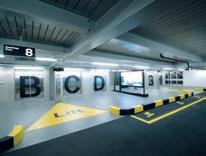

CONSTRUCTION MANAGEMENT NOVEMBER/DECEMBER 2022 | 3 Contents nconstructionmanagement.co.uk 11/22 Contents News 04 News in pictures 06 News: 100th D&I Charter sign-up 08 News: CM safety at height survey 10 Data: Don’t cut green investment Opinion 12 Caroline Gumble on ethical CPD 13 Feedback: Readers’ views SMEs 14 Success with a smaller business Technical 20 The benefits of becoming a CEnv Global 24 Is Qatar 2022 a game changer? 26 Qatar’s World Cup stadiums Structural Steel Design Awards 2022 29 Cover and sponsors 30 Introduction 30 Bombardier Maintenance Hangar 32 Compton and Edrich Stands, Lord’s 34 Esperance Bridge, King’s Cross 36 1 Triton Square, London 38 Tower of Light, Manchester 40 Commendations 41 Merits Partnership 44 Cloud working with Bluebeam CPD 46 Refurbishing concrete car parks Legal 50 Contract clinic on site trespass Careers & Recruitment 52 This much I know: Marek Suchocki of Autodesk 54 Job spotlight: Senior cost manager, Turner & Townsend Community 56 CIOB Scotland Awards winners 57 Birmingham Hub hospital site visit 58 Pexhurst: 20 years as a CBC 59 Building Equality’s outreach event 62 Getting ready for Teambuild 63 Gardens makeover in Scarborough 64 CIOB launches Academy Zones Diary dates 66 What’s on over the next month 54 30 14 46
Hull Maritime Museum refurb takes shape
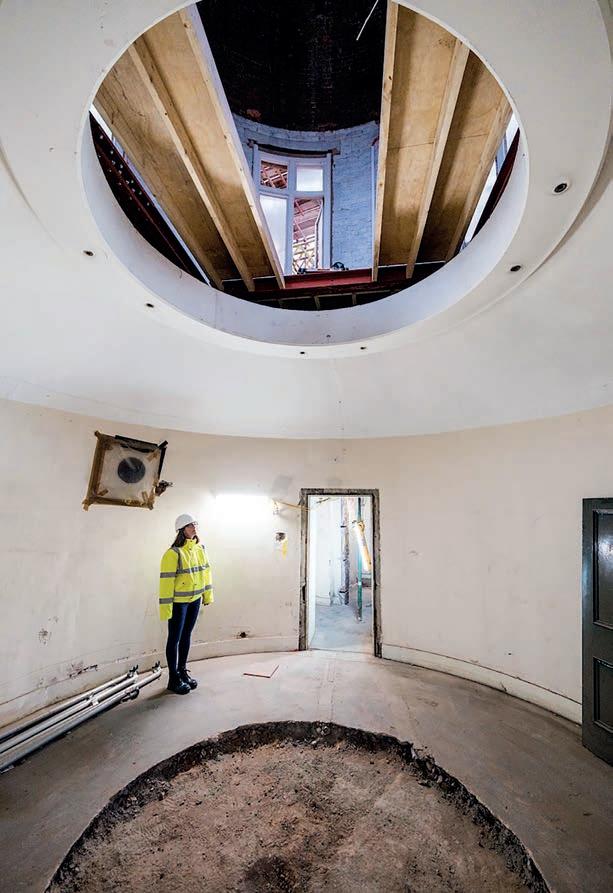
Heritage contractor Simpson (York) has revealed the original Victorian architecture of Hull Maritime Museum, as part of works involved in its £12m, 20-monthlong refurbishment. Simpson is working to build a new main atrium with a glass roof and a new lift to all the floors. A new staircase will give visitors access to one of the domes, offering views of the city.
SRM raises £56,000 for ParalympiansGB
Sir Robert McAlpine has raised £56,000 for ParalympiansGB, following a charity event at London’s Science Museum to support athletes on the road to the Paris 2024 Paralympic Games. Athletes present included seven-time Paralympic champion Hannah Cockroft; Britain’s most successful Boccia player ever, David Smith (pictured with SRM CEO Paul Hamer); and Paralympic rowing champion Lauren Rowles.

4 | CONSTRUCTION MANAGEMENT NOVEMBER/DECEMBER 2022 n News constructionmanagement.co.uk
NEIL HOLMES PHOTOGRAPHY WWW.MARTYNHICKS.COM
Want to become CEnv? Emma Nicholson is one of many MCIOBs who have become Chartered Environmentalists, p20

Giant HS2 cutterhead transported to new dig

Contractors working for HS2 have transported a 160 tonne tunnel boring machine cutterhead to a new digging site in a complex overnight operation. Tunnel boring machine Dorothy made its first tunnel breakthrough in July this year in HS2’s Chiltern Tunnel at the south portal. Now Balfour Beatty Vinci (BBV) has moved the cutterhead back to the north portal.
Restoration of Battersea Power Station complete

The restoration of Battersea Power Station in London is now complete, as part of a £9bn redevelopment programme in the area. Mace was construction manager for the structure’s restoration, which is home to Apple’s new London campus. It also includes around 100 retail, food and beverage units, a chimney lift experience and 254 flats.
Inclusive PPE range launched
Personal protection equipment (PPE) supplier Cromwell has launched an inclusive range of products – Halo – designed to meet the needs of a diverse workforce. Products include a unisex metatarsal protection trainer, female-specific footwear designs and a wider range of sizes. There are also trousers, tops and jackets specifically produced for females.

CONSTRUCTION MANAGEMENT NOVEMBER/DECEMBER 2022 | 5 News nconstructionmanagement.co.uk
WILKINSONEYRE
CROMWELL PROPERTY GROUP
Laing O’Rourke is 100th firm to sign CIOB D&I Charter
Contractor’s D&I head Emma Shakespeare urges other construction businesses to get on board
She said: “Driving change not just within our own organisation but across the industry is something that we are committed to as a business.”
Earlier this year, Laing O’Rourke set up a cross-industry diversity and inclusion (D&I) forum. It brings together D&I leads from across the industry to share best practice. Companies involved include Balfour, Mace, Kier, Skanska, Costain.
Shakespeare said: “We are really keen at Laing O’Rourke to drive some of the industry change that is needed. One of the things that we have implemented is our equal parenthood leave policy. Within that forum there has been a lot of interest in what we have done.”
Laing O’Rourke has become the 100th organisation to sign up to the CIOB Diversity and Inclusion Charter.
The charter aims to promote diversity and inclusion in the workplace, highlighting a growing body of evidence that suggests it is key to a construction business’s success. It can be tailored to any size of organisation and environment.

Emma Shakespeare, head of diversity, inclusion and belonging at Laing O’Rourke, said the company had signed the charter as it wanted to join its peers in the industry to drive change. The company has set a target to achieve gender parity by 2033 as well as increasing the number of females in senior delivery roles and on projects.
The CIOB charter aims to promote diversity in the workplace
And she encouraged more companies to sign up to the CIOB charter. She said: “Together, we can make that change and we can start to make the industry a better place to be for everyone and attract that diverse talent that we are all looking for.”
Mark Harrison, head of equality, diversity and inclusion at CIOB, said: “Having 100 companies signed up to the charter is a massive milestone for us and our industry and demonstrates positive progress towards a more inclusive, welcoming and representative sector.
“Signing the charter enables companies to show they want to help make the industry more representative of the wider population and sends a message to potential recruits that they want to attract
Together, we can make that change and we can start to make the industry a better place to be for everyone and attract that diverse talent that we are all looking for Emma Shakespeare, Laing O’Rourke

the best talent from all walks of life – which, it is recognised, improves employee belonging and enhances credibility with clients. The number of companies signed up to the charter continues to grow and we look forward to even more opting to join.” ● To find out more about the CIOB Diversity and Inclusion Charter, and to sign up, go to www.ciob. org/specialreport/charter/ diversityandinclusion.
The five core actions of the charter
1. Show leadership.
Make a plan.
Shape the culture.
Be transparent.
Be accountable.
6 | CONSTRUCTION MANAGEMENT NOVEMBER/DECEMBER 2022 n News constructionmanagement.co.uk
2.
3.
4.
5.

Inside CM:
practice
Construction workforce still ignorant of work at height risks

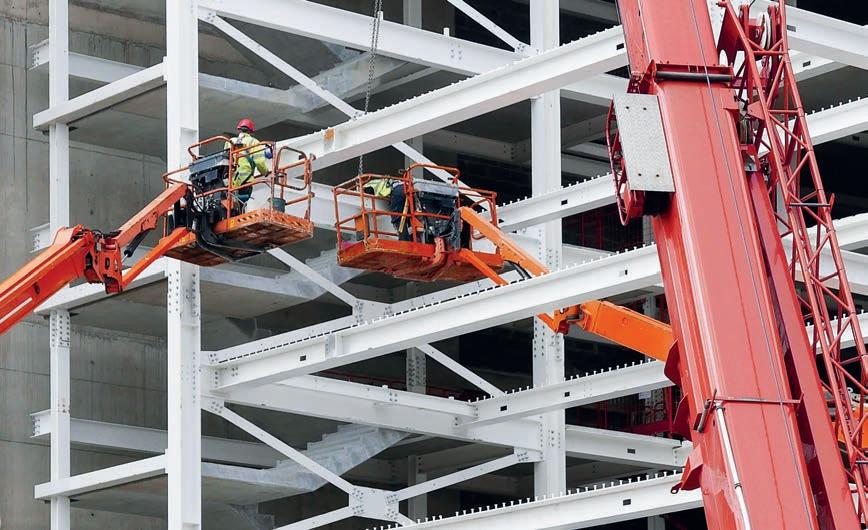
CM survey for Safe Working At Height Week (7-13 November) finds widespread safety concerns about working at height. By Neil Gerrard
Nearly 60% of construction professionals think the industry’s workforce does not fully understand the risks involved with working at height.
That’s according to a new survey by CM for Safe Working at Height Week (7-13 November). The campaign brings together professional bodies, trade organisations and
campaign groups to highlight the key issues surrounding current practice and future developments in safe working at height.
An emphatic 98.6% of the 200 construction professionals surveyed agreed that working at height is still a significant safety risk in the sector.
When it came to the types of equipment that they feel present the
Specifying appropriate access equipment was voted the best way to reduce accidents
most risks, construction professionals highlighted ladders (selected by 88.8% of respondents) as posing one of the biggest dangers. That was followed by mobile access towers (56.6%) and scaffolding (41.3%).
Meanwhile, respondents identified three main ways to reduce risks and accidents while working at height.
Specifying access equipment that is appropriate to the task and in good working order was the most popular route (selected by 79%). That was followed closely by better work planning to reduce work at height, such as the use of modular building (76.2%), and proper use of fall arrest, edge protection and other safety systems (74.1%).
●
8 | CONSTRUCTION MANAGEMENT NOVEMBER/DECEMBER 2022 n News constructionmanagement.co.uk
NATIONAL ACCESS AND NASC YEARBOOK 2023 CELEBRATING INNOVATION, PRACTICE AND GOOD DESIGN IN SCAFFOLDING
NASC’s 2023 Yearbook celebrates innovation and best
in scaffolding
Comments from CM readers:
“Increase frequency of refresher courses to maintain awareness.”
“There is still a human factor with all tasks. We need to ensure our operatives understand the risks fully and implement safety measures.”
“Not enough planning by suppliers and subcontractors takes place. Supervisors do not have time and are ill equipped to make a judgement on the type of equipment required. This results in equipment not suited for the task.”
“All MEWPS should have a lift plan before being put into use. This will ensure that the right type is used.”
“It is unplanned work that presents a significant risk, as well as complacency or reduced standards in the race to finish projects.”
“Avoidance of work at height is often not considered at the design stage because the use of readily available access equipment is often the cheaper option, so preferred by client.”

A survivor story: The real-life repercussions of a fall from height
On 3 January 1993, I was 24 years old. I was married with a couple of young children. I was working as a labourer in construction for my father-in-law’s small roofing company.
It was the first day back after the Christmas holidays. My morale was low. We were asked if we could try to fix a leaking roof on another building.
We were eager to please the client, but the work was unplanned. After finishing the job, I went down an unsupported ladder, which slipped. I fell 10ft (3m).
In hospital, I received the devastating news that I would never walk again.
I spent four months in a spinal rehabilitation centre in Sheffield and learned how to live in a wheelchair.

I came home from hospital on 25 April 1993 and my wife left the next day, taking my two children. It was during the early 1990s recession and we were having marriage problems before that. It had a massive impact on my already poor emotional state.
I didn’t know how to speak about how I was feeling. I was drinking quite heavily at the time and I moved on to taking ecstasy. It wasn’t to have an enjoyable time – I just couldn’t cope.
Things rapidly fell out of control. In January 1995, I had an unintentional drug overdose. It put me in a coma. After a five-month recovery, I found I now couldn’t move my arms properly.
My daughter came back to try to help give me some focus. I battled through life. But I was still battling a number of demons.
In 2007, I finally got offered £408,000 in compensation. In 2008, I had a chance meeting with a guy called Dan Terry, who worked in behavioural safety. He suggested I start sharing my story with industry. Dan set me on a path to talking more openly about the impact that safety failing on 3 January 1993 has had on my life and my family.
On that day, I was in a bad place. I realised the job I was being asked to do was unsafe. I stopped, I thought about it, and I still did it.
When people are under pressure, they use equipment incorrectly. Management also needs to understand this. If you have a mental health issue, and are in a similar situation, speak up before something terrible happens.
Jason Anker is a speaker on behavioural safety training and a patron of the No Falls Foundation.
CONSTRUCTION MANAGEMENT NOVEMBER/DECEMBER 2022 | 9 News nconstructionmanagement.co.uk
Jason Anker was 24 years old when he suffered a life-changing fall from height. He describes the extensive physical and emotional repercussions
What types of equipment do you feel present the most risks when working at height (%) 0 102030405060 70 8090100 n Scaffolding n Powered access n Mobile access towers n Rope access/abseiling n Ladders What can help reduce risks and accidents when working at height? (%) 0 102030405060 70 8090100 n Better work planning to reduce work at height, e.g. use of modular building n Specifying access equipment that is appropriate to the task and in good working order n Proper use of fall arrest, edge protection and other safety systems n Use of digital technology to help understand risks Show your support: Tweet or post on LinkedIn with the hashtag #SafeWorkingAtHeightWeek
The percentage of the UK’s total greenhouse gas emissions for which the built environment is responsible, as reported by the UK government in September 2022
Delivering low-carbon construction isn’t a luxury – it’s essential
Looming recession may make clients and contractors reassess the business case for sustainability investments. But it’s vital not be thrown off course, argues Kris Hudson

When it comes to sustainability, the national and the construction industry data paint quite different pictures. Across the whole economy, the UK’s commitments to reducing emissions have been bearing fruit, with greenhouse gas (GHG) emissions reducing by 42.6% over the last 30 years. Meanwhile, construction has not been performing so well, with an overall increase of 23.3% in GHG over those same three decades –although recent progress has been made (see top chart opposite).

The increase has particularly been led by specialised construction works, with a 73.3% rise in GHG over that 30-year period. This includes all specialist trades, from energyintensive pile driving and concreteheavy groundworks to erecting high-carbon steel structures.
Improvements are possible, but not cheap. Specialised construction activities are usually carried out by subcontractors and tier 2 or 3 contractors. These are often SMEs, which are particularly vulnerable to the changing economic climate.
Facing high inflation, high interest rates and a likely recession, both clients and contractors may reassess the business cases
For many clients the incentive must lie in improving investment cases. The industry must drive programme productivity to keep costs in check
behind planned sustainability investments. Premiums associated with procuring and delivering low carbon construction may seem unaffordable luxuries.
But it is vital that the cases for investing in sustainability are strengthened, so that short-term economic difficulties don’t worsen the long-term sustainability crises.
Some of this will be achieved via government intervention – and ambitions are lofty. Government is hoping to reduce annual emissions in buildings by 55.5 tonnes of CO2 by 2037, requiring manufacturing and construction emissions to reduce by 64.4% (see chart below right).
Recently, in June, the Building Regulations increased requirements for new buildings to reduce carbon, including expecting 30% lower emissions from new-build homes. And the £2.9bn Public Sector Decarbonisation Scheme will help sustain interest in retrofitting publicly owned buildings and encourage expansion of the UK’s retrofit market.
But for many clients the incentive must lie in improving investment cases. The industry must drive programme productivity to keep costs in check and show those planning capital projects that they need not choose between improving sustainability and delivering maximum value.
Awareness of the long-term operational savings from net zero and sustainability is growing, so if the upfront investment costs can also be show to be lean and efficient, green investment will remain appealing despite the economic turbulence. Kris Hudson is an economist and associate director at Turner & Townsend.
UK total and construction greenhouse gas emissions over the past 30 years
Total greenhouse gas emissions Construction greenhouse gas emissions Index (1990 = 100)
UK historical emissions compared to the government’s pathway by sector

10 | CONSTRUCTION MANAGEMENT NOVEMBER/DECEMBER 2022 n Data constructionmanagement.co.uk
25
160 140 120 100 80 60 40 1990199219941996199820002002200420062008201020122014201620182020 160 140 120 100 80 60 40 20 0 1990 1999 2008 2017 2026 2035
Historical buildings Government pathway buildings Historical manufacturing & construction Government pathway manufacturing & construction Emissions: MtCO2e (metric tonnes of carbon dioxide equivalent)
 Caroline Gumble CIOB
Caroline Gumble CIOB
Putting ethical practices at the heart of learning
The CIOB’s CPD policy is changing, with a new focus on ethical practices to support the ongoing culture change in construction. Caroline Gumble explains

As we move towards the end of a very busy year, I want to look to next year and one of the changes CIOB is making to continue supporting our members and progress in the industry.
Members will be aware that undertaking CPD – continuing professional development – is a mandatory part of chartered membership with CIOB. Members might also be aware that we have been examining our CPD policy this year under the leadership of a working group sitting within the Professional Standards Committee.
The outcome of their work has resulted in more structure and
focus around our CPD requirements. The working group found a ‘common principle’ that no matter what your role in the industry, ethical practice is a universal and uniting theme and the need to reflect on the ethical implications of learning in practice is common to all professions. Therefore, the change to our CPD policy is to require members to focus on the ethical aspects of any learning they undertake.
Ros Thorpe, CIOB’s director of education and standards, gives an excellent example of why this is important and how to put it in context. She offers the example of

No matter what your role in the industry, ethical practice is a universal and uniting theme
a surgeon learning a new technique for heart surgery – although the learning may be very technical in nature, it also requires that the doctor is able to outline any risks to the patient and to be clear where this type of surgery would and would not be beneficial. This is applying learning ethically in practice, requiring the practitioner to think about the implications of what they have learned.
Construction’s culture shift
Part of the rationale behind this is to support members in playing their part in construction’s culture shift, with a drive towards professionalism and a focus on the delivery of quality. This move aligns with the values of ethics and leadership which are a commitment all CIOB members make and follows the ‘moral compass’ theme of our current corporate plan and the focus on ‘modern professionalism’ which is at the heart of our next plan.
The CPD required of members during 2023 allows for learning activities which build on ethical practice through reflective learning. It will also enhance the image of this important industry and help drive individuals towards a more professional standing. Watch this space for details on how CIOB will be supporting this move in the next few months. ●
Caroline Gumble is CEO of CIOB.
12 | CONSTRUCTION MANAGEMENT NOVEMBER/DECEMBER 2022 n Opinion constructionmanagement.co.uk
Send in your comments to CM at constructionmanagement.co.uk or email: construction-management@atompublishing.co.uk.
Where should heat pumps be sited?
Luke Osborne’s article on heat pumps generated some animated responses from CM readers, including the question of where heat pumps should be positioned
CM 10/22
CM’s article on heat pumps last month (‘Heat pumps: dispelling the myths’) came as the Competition and Markets Authority (CMA) is examining whether it needs to protect consumers from poor practices in the green heating and retrofit sectors. The CMA said it wanted views from consumers, businesses and other interested groups as more people switch to solutions like heat pumps amid the energy crisis.
D Pearson MCIAT
I have been thinking about air source heat pumps and in particular their position next to the building they are meant to be heating. I think that there is a theoretical chance that when an air source heat pump is placed next to a wall of the building it is meant to be heating it will actually suck out as much from that external wall as it puts in.
I liken it to the rising damp scenario where you put an air dehumidifier in a room to reduce the moisture content in the atmosphere, the high level of moisture being due to the damp rising up through the wall and then evaporating into the room.
When you put the air dehumidifier on, it removes the moisture from the air which in turn allows the raising damp to immediately replace the removed moisture, so increasing the raising damp flow and making the situation worse.
Steve Frizell (responding to D Pearson)
The scenario presented appears to be two different effects: that of dehumidifying to deliberately draw moisture out of an internal room space and, by extension, out of the enclosing structure with some heating and a reduced relative humidity. This should be self-
The positioning of heat pumps is crucial to effective operation
 Steve Frizell
Steve Frizell
limiting if effective damp proof membranes (DPMs) and damp proof courses (DPCs) are in place.
This is different to creating a greater temperature gradient across a structure due to reduced external temperature, perhaps inadvertently causing a dew point to arise within the structure, in the absence of a DPM and DPC.
An air-source heat exchanger should be sited and orientated to blow cooled air away from adjacent walls. The examples I’ve seen (in Scotland), are set away from the wall. If the orientation and opportunity for free circulation of air is poor, then certainly cooled air could recirculate and effectively create a self-reinforcing ‘cold trap’. This will lead to higher heat loss through the chilled walls, and also reduce the efficiency of the exchanger performance.
Other considerations include prevailing wind direction and solar orientation to take advantage of warmer ambient air conditions.
CONSTRUCTION MANAGEMENT NOVEMBER/DECEMBER 2022 | 13 Opinion nconstructionmanagement.co.uk
If the orientation and opportunity for free circulation of air is poor, then cooled air could recirculate and effectively create a self-reinforcing ‘cold trap’
Can you survive and thrive as a construction SME?
SMEs are the backbone of construction, but it can be tough competing with the big beasts. Neil Gerrard looks at the challenges and the success stories
There are hundreds of thousands of construction companies in Great Britain – 342,456 to be exact.
Of those, by far and away the largest proportion are companies with fewer than 250 employees – the common definition of an SME. But life as an SME can be a challenge, particularly in construction, where long supply chains and complex contractual arrangements can leave a lot of power sitting with the big beasts, often at the expense of their smaller counterparts.
So what are the challenges facing construction SMEs, and what can they do to overcome them and thrive in a notoriously competitive sector?
‘Not natural entrepreneurs’ “I’m not being unkind when I say this, but I think a lot of business owners in construction are not natural entrepreneurs,” says Maria Coulter, who runs SME consultancy Construction Coach. “They might start a business because they are good at a skill. But nobody really teaches you how to build a business.
We should be looking at this from an education perspective.”
Coulter worries about construction SMEs making a decent profit margin.
“Do margins have to be so low? If you are not making the level of profit that you need, how are you going to grow your business, invest in new technology and innovation?”
Other challenges Coulter recognises are juggling different responsibilities in small organisations – such as getting to grips with technology, not knowing where to get help and support and having ‘limiting beliefs’ – that hold business owners back from achieving.
She adds: “There is fear about the competition and the fact that we are seen as a commodity industry. It is hard to differentiate yourself. People in small businesses have got it fixed in their head that it should be about the lowest price. But they aren’t presenting clients with anything else to make a decision on. There is a lot of work needed to understand what value really means and why clients should pay more for it.”
Maria Coulter, Construction Coach
Five tips for SMEs
Ideas for small businesses from consultant Maria Coulter
1 Be more proactive when it comes to seeking out the support you need. Don’t to be afraid to ask for help.
2 Tap into Local Enterprise Partnerships, and their local growth hubs in particular (www.lepnetwork.net/ local-growth-hub-contacts).
3 Join trade associations and membership organisations, as well as connecting with local universities.
4 Take advantage of free resources like Futurelearn (www.futurelearn.com) which is a platform for mass open online courses (MOOCs).
5 Promote and prioritise closer working relationships between SMEs, principal contractors and clients. Maintain open and constant dialogue with the rest of your supply chain.
14 | CONSTRUCTION MANAGEMENT NOVEMBER/DECEMBER 2022 n SMEs constructionmanagement.co.uk
There is a lot of work needed to understand what value really means and why clients should pay more for it

CONSTRUCTION MANAGEMENT NOVEMBER/DECEMBER 2022 | 15 SMEs nconstructionmanagement.co.uk
Practical
Dr Nicola Thompson,
compliance and performance director at consultancy Pick Everard, there are five key practical challenges that SMEs face: staff retention, cash flow, late payment, rising costs and difficult jobs.
She says: “For SMEs, budgets
do not allow for extensive
programmes for staff and it is difficult to promise hardworking professionals that they will be working on multi-million-pound
skills shortages
average wages
SMEs will struggle to keep hold of staff.”
Dan Maher, managing director of Arc Partnership, a joint venture
body Scape and Nottinghamshire County Council that works particularly closely with SMEs, also sees challenges in labour, supply chain resilience and inflation.
often only
in the context of
Ultimately, if SMEs fail, principal contractors and their clients fail. An effective socially conscious response involves principal contractors managing their SME supply chains fairly

Dan Maher, Arc Partnership
principal contractors,” says Maher. “For SMEs, they represent significant downward pressure in terms of pricing as well as retaining labour.”
Seeking support
wants to see the wider industry working as one to engage clients and share the financial burden presented by current market conditions. “Ultimately, if SMEs fail, principal contractors and their clients fail. An effective socially conscious response involves principal contractors managing their SME supply chains fairly,” he says.
16 | CONSTRUCTION MANAGEMENT NOVEMBER/DECEMBER 2022 n SMEs constructionmanagement.co.uk
challenges According to
group
often
training
contracts. With
worsening and
increasing,
between procurement
“These issues are
discussed
Size of firm (by number employed) Current prices (£bn) 0-4 28.6 5-9 13.9 10-19 14.2 20-99 28.9 100+ or ≥£60m turnover 65.5 Construction firms: Value of work done by size of firm and type of work in 2020, Great Britain SOURCE: ONS
Maher
● Size of firm Number of firms in 2020 0 (sole proprietors) 36,891 1 148,584 2-3 94,651 4-7 36,725 8-13 13,269 14-24 6,633 25-34 1,937 35-59 1,913 60-79 584 80-114 441 115-299 573 300-599 143 600-1,199 58 1,200 and over 54 Construction firms: Number of firms, by size of firm, Great Britain
SOURCE: ONS
men. Now we have a gender split of 50/50. It creates a whole different vibe to the place and we have our first female director.
We were an early adopter of Revit and BIM. It was a big investment, but we have developed our expertise and it has helped us with the cladding business.
Our cladding work is very specific. It’s difficult finding people in the architectural world who are prepared to sit and redesign what someone built in the last 20-odd years and make it work. They would prefer to be creating new buildings with sweeping curves, not working through what is going to satisfy fire engineers, building control officers and structural engineers.
Meanwhile, the cost of professional indemnity insurance has quadrupled for us in the last three years. Although, as our broker says, we are lucky to have it. We just have to grin and bear it and try to get it back through our fee levels, although there is always a general downward pressure on fees in the public sector.
‘Developing our BIM expertise helped our cladding business’
Chris Bula MCIOB is a director at BPG Architects + Surveyors.
He joined the business 33 years ago, just after it was founded. The (now) employee-owned business performs a range of services and has carved out a niche specialising in cladding remediation

Surviving for 34 years is no mean feat. Riding the whole ridiculous boom and bust cycle can be tiresome. We were fortunate and received an appointment from Wandsworth Council to deal with combustible cladding on two residential towers. Everyone was finding their feet with this after Grenfell and we made it happen.
Since then, we have been involved in 16 different cladding remediation schemes both as designers and providing a full service for an aggregate construction value of circa £75m. It has been our bread and butter.
On another positive front, the company is much more diverse than it was. It used to be nearly all young
BPG replaced combustible cladding on two residential blocks for Wandsworth Council

CONSTRUCTION MANAGEMENT NOVEMBER/DECEMBER 2022 | 17 SMEs nconstructionmanagement.co.uk
Our cladding work is very specific. It’s difficult finding people who are prepared to sit and redesign what someone built in the last 20-odd years and make it work
Chris Bula, BPG Architects + Surveyors
‘You get more responsibility, more quickly’
UC Build was founded in 2015 and has grown to 51 employees and turnover of around £50m this year. Director Neil Hennessey FCIOB joined the business from a major tier 1 contractor to set up a northern office in 2020 based in Doncaster


James Halksworth [another director] and I ran a retail construction delivery business for a tier 1 contractor for 10 years. That operating model is vastly different from what we have now. You have all the support functions you need, like estimating, planning, project support, document controllers. In an SME you don’t have all that. Price is absolutely everything – right down to office equipment.
The positive piece is you have a touchpoint on all of it. You are not delegating that role to your
team. You also have a lot more red tape in bigger organisations. We can make sure our processes are relevant and cut to the point where we are not overloading our team.
Recruitment is very different in a tier 1 environment compared to an SME. Talented young people are blindsided by a bigger badge. We can’t always offer the benefit package or what is perceived to be a traditional career path. However, we maintain that if we can get hold of that bright young thing, they are going to be exposed to more responsibility at a much quicker pace.
Another challenge is that, while we have a few years under our belts, new companies can struggle to obtain a credit rating or confidence in the market. Unless you have a strong relationship with a client that is willing to grow with you, that mindset is more or less impossible to change.
We have to first of all break a client –find a lead and convert that lead into an opportunity. But actually seeing something go from cradle to grave does give you a massive sense of achievement
Neil Hennessey, UC Build
We have to first of all break a client – find a lead and convert that lead into an opportunity. But actually seeing something go from cradle to grave does give you a massive sense of achievement. We’re excited for the future. The SME can be quite a niche role and if a contractor can find the right markets, I personally believe clients get best value from SMEs.
‘Nurturing homegrown talent is imperative’
Martin Sandall, managing director of Kent-based contractor and Chartered Building Company Jenner, on why he finds running a construction SME rewarding
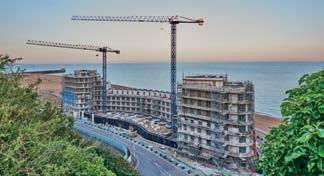
We pride ourselves on the strong team of talented, experienced people we have developed. This is backed by a focus on nurturing homegrown talent which is so imperative for progression and business longevity.
In my 14 years as MD, I have navigated the business through the financial crash of 2008 and the subsequent recession, and Brexit. We are hopefully at the end of a global pandemic, but we now have political unrest and the conflict in Ukraine. We are now immersed in the aftermath and know the effect of these challenges in the form of spiralling materials costs, a shortage of skilled labour and diminishing confidence in an unpredictable market.
But I am a firm believer that out of adversity comes greater resilience. For a privately owned business like ours,
it is all about careful, hands-on and accessible management, understanding the marketplace and our client needs, and nurturing relationships throughout our entire supply chain.
18 | CONSTRUCTION MANAGEMENT NOVEMBER/DECEMBER 2022 n SMEs constructionmanagement.co.uk
It is all about careful, hands-on and accessible management, understanding the marketplace and our client needs
Martin Sandall, Jenner
MATT
ROWE

Join the green team
As COP27 comes around, construction professionals may be wondering what’s involved in becoming a chartered environmentalist. Kristina Smith talks to four CIOB members who have done just that

20 | CONSTRUCTION MANAGEMENT NOVEMBER/DECEMBER 2022 n Sustainability constructionmanagement.co.uk
For Melvin Keyani, QEHS director at M&E specialist Cilantro, sustainability and environmental issues are a hands-on affair. He once ran his own building company and is focused on making sure that workers on site have the information and training they need to do things properly.

“You can write a fantastic policy or procedure but if you don’t monitor whether it’s being used, it is pointless,” Keyani says. “London is a subcontract, self-employed construction industry where the guys are on price work. For them environmental issues at the bottom of their list. That’s where I come in.”
The little things are important, he says, such as making sure hazardous waste isn’t thrown into general waste skips or setting up reuse areas for pipes and cables. “These are small steps but over a £30m project, there can be quite a substantial saving
Keyani: “Get the knowledge and experience first”
and if you have six or seven projects across London, it all adds up.”
Keyani’s first job in construction was carrying bricks while he studied for his construction management degree. It was not until his late 20s that he moved into environmental, health and safety management, working initially for DW Contractors in Oxford.
More recently, working with firms such as Mace, he has taken a keen interest in the governance side of sustainability, deploying standards such as ISO 14001 Environmental Management Systems – which Cilantro achieved in 2017 – and BES 6001 Responsible Sourcing of Construction Products.
“Get the knowledge and experience first,” Keyani advises others going for CEnv. “Working with principal contractors and other supply chains, I learn so much about what other people are doing.”
Walking around Cilantro’s projects to run checks is a big part of his role, but Keyani is keen to find more efficient ways to do things.
CIOB and SocEnv
The construction industry has never seen greater demand for sustainability expertise – and one way to demonstrate competency is through gaining chartered environmentalist status, CEnv, from the Society for the Environment (SocEnv).
Having saved significant quantities of carbon and cash by switching to apps from paper systems, he wants to make digital tools easier for older and migrant workers. He uses videos and photos for some risk assessment and method statements.
Keyani is currently studying for a doctorate at Anglia Ruskin University, looking at the usability of digital management systems and the ageing population.
CV: Melvin Keyani, QEHS director, Cilantro Engineering
l FCIOB, CEnv, CMIOSH
l Worked with Cilantro Engineering from 2016 to 2018 and then from 2020
l Currently studying for PhD at Angela Ruskin University
l Worked as environmental health and safety manager from 2009
l Ran his own small building company after graduating
l BSc Construction Management, Oxford Brookes University
SocEnv is an umbrella organisation that licenses other professional bodies from almost every sector to award the CEnv qualification. CIOB is one of those bodies. The application process for those CIOB members who want to become a chartered environmentalist
involves submitting a master’s-level written application, which is followed by a professional interview with specialist assessors.
SocEnv has awarded some 7,500 CEnvs since 2004 across all industries. More info: ciob.org/ chartered-environmentalist.
CONSTRUCTION MANAGEMENT NOVEMBER/DECEMBER 2022 | 21 Sustainability nconstructionmanagement.co.uk
‘Get the message to the coalface’
You can write a fantastic policy or procedure but if you don’t monitor whether it’s being used, it is pointless Melvin Keyani, Cilantro Engineering
The biggest challenge in getting people to behave more sustainably is convincing them to change, says Greg Chant-Hall, director of consultancy Square Gain.

“People are scared of doing things differently – they see it as them having to take a risk personally,” he says. “They don’t need people talking sustainababble such as ‘net zero’ or ‘circular economy’ without explaining them properly.”
Chant-Hall has been working in the construction sector for over 20 years, including two stints with
Skanska. The second of these saw him start as sustainability manager on the group’s £1.1bn Barts and Royal London hospitals PFI, moving up to oversee all projects globally where Skanska had a financial stake.
At Square Gain, he works with organisations across the built environment, from financiers to supply chain companies. The consultancy provides training and e-learning resources, helps councils work out routes to their zero carbon goals and recently wrote what Chant Hall says is “the world’s first net zero building standard” for NHS England.
Chant-Hall, who gained his CEnv status over a decade ago, thinks the best thing about the accreditation is how it links across different sectors, whether financial, construction, logistics, retail and more.
“CEnv joins the dots,” he explains.
“It is saying that the environmental management piece is part of everyone’s job and that it’s good for society and good for business. It gives individuals recognition, but it should make their businesses better too.”
l MCIOB, CEnv, FIEMA, FRSA, MCIBSE
l Director of sustainability consultancy Square Gain since 2017
l Director of The Carbon Free Group, a consortium of companies dedicated to low carbon and sustainable living, since 2018
l Worked for Skanska 2005-2009 and 2011-2018, rising to head up sustainability for global investment projects

l First role with CIRIA in environment team
l BSc Geography and Environmental Science, University of Surrey
Emma Nicholson’s passion for sustainability dates back 15 years, and runs through her day job, volunteering and mentoring others.
“The built environment particularly has a critical role to play in reducing greenhouse gases and tackling the climate and biodiversity emergencies the planet is facing,” she says.
“There is a pressing need for more chartered environmentalists and for all built environment specialists to keep up with key legislation.”

22 | CONSTRUCTION MANAGEMENT NOVEMBER/DECEMBER 2022 n Sustainability constructionmanagement.co.uk
‘Let’s banish sustainababble’
CV: Greg Chant-Hall, director, Square Gain
‘We are going to see a green revolution’
CEnv joins the dots. It is saying that the environmental management piece is part of everyone’s job Greg Chant-Hall, Square Gain
Nicholson’s career began outside construction. Having studied a degree in English Literature, she worked in journalism and PR and was working in interior design when the opportunity to apply for a job as a trainee project manager arose.
After gaining a construction project management degree, and working across different sectors, Nicholson’s interest in sustainability and environmental issues grew. She gained her environmental chartership in 2010 and in the same year and was hailed as a ‘rising star’ by the Society for the Environment. She then worked as venues sustainability manager for the 2012 Olympic and Paralympic Games.
She recently moved to Pick Everard, where she is a principal sustainability project manager.
“Now I’m in a position where I’m applying my experience every day, working directly on all manner of projects from client decarbonisation to promoting sustainable processes and best practice across the industry,” she says. “We are going to see a green revolution.”
CV: Emma Nicholson, principal sustainability project manager, Pick Everard
l FCIOB, CEnv, FIEMA, FAPM
l Joined Pick Everard in September 2022
l Founded the Women in Sustainable Construction & Property LinkedIn community in 2011
l First job in construction as assistant project manager in 1998, then worked for various consultancies as project and sustainability manager
l MSc in Construction Project Management from South Bank University
l Degree in English Literature
There is a pressing need for more chartered environmentalists and for all built environment specialists to keep up with key legislation Emma Nicholson, Pick Everard
‘Include sustainability in everything you do’
There won’t be many CIOB fellows who have worked on as diverse a range of projects as Peter Egan. Over his 26 years in the Royal Engineering Corps, he has worked in Macedonia, Iraq, Afghanistan, the Falklands and South Sudan.

Egan was always interested in environmental and sustainability issues. When he qualified in 2011 to become a ‘clerk of works’ – a military term for someone who produces high-level engineering designs and provides expert advice on projects – he started to take positive action.
“I started to understand the impacts of the buildings and infrastructure we were constructing, and I tried to include sustainability in everything we did,” he says.
Egan’s green achievements including cancelling out the carbon emissions from concrete in a new accommodation building on the Falkland Islands – replacing cement with ground granulated blast furnace slag (GGBS) and planting trees to offset the rest – and using vernacular materials and local tradespeople on two huge hospital projects in South Sudan.
Peter Egan, Strategic Command
At his membership interview for CIOB, his sustainability knowledge was so evident that he was advised to apply for the chartered environmentalist accreditation. Now he is part of CIOB’s validation process for new CEnv applicants.
“Chartered environmentalist status gives you extra credibility and validation when you are discussing technical issues,” says Egan. l
CV: Peter Egan, requirements portfolio manager, Strategic Command
l FCIOB, CEnv, CEng, FInstRE
l Set up sustainability consultancy EGS Consult in 2021, ahead of retiring from army l Roles in the military have included project manager and structural designer for infrastructure projects around the world, planning and implementing engineering projects in the UK, overseeing training at the Corps of Royal Engineers Professional Engineering Wing and working for Strategic Command
l Joined HM Forces (Army) Corps of Royal Engineering in 1996
l MSc Sustainability and Adaptability in the Built Environment, Centre for Alternative Technology
CONSTRUCTION MANAGEMENT NOVEMBER/DECEMBER 2022 | 23 Sustainability nconstructionmanagement.co.uk
I started to understand the impacts of the buildings and infrastructure we were constructing, and I tried to include sustainability in everything we did
Qatar 2022: a game changer for worker exploitation?
Rod Sweet examines how the World Cup construction programme turned the spotlight on supply chain ethics, leading to CIOB’s campaign to stamp out modern slavery
Qatar won the hosting rights for the 2022 FIFA World Cup back in 2010.
Twelve years later, the moment is almost here: the host nation faces Ecuador in the opening match on 20 November.
Awarding the tiny Gulf state the tournament was controversial at the
time, and has become even more so since. The wholesale transformation of Qatar’s built environment, to prepare for the tournament, has made had made the country a global emblem of worker abuse.
In 2014, CIOB began its campaign against modern slavery in construction during its Members’
Human rights groups have criticised Qatar’s World Cup construction programme for its treatment of workers

Forum, which it held – aptly – in Qatar. By then, a bevy of human and labour rights organisations were decrying the hated kafala system of sponsorship. Common in the Gulf region, kafala prevented migrant workers from switching employers without their employers’ consent, creating the conditions for de facto modern slavery.
On top of that was a continual stream of reports about workers racking up unmanageable debt through exorbitant and illegal recruitment fees, rampant wage theft, and hair-raisingly unsafe working conditions. Rights groups predicted that the price for our enjoyment of the tournament –and the handsome profit FIFA would make from it – would be thousands of preventable deaths and injuries, and thousands of already vulnerable families pushed into greater misery and penury.
‘Victory’?
Qatari authorities did engage with rights groups’ concerns. After years of tinkering, the government officially ended the kafala system in 2020, becoming the first state in the Arab Gulf region to do so. It introduced a basic minimum wage and established a labour dispute resolution process, among other reforms.
After her 10-year campaign for labour rights in Qatar, Sharan Burrow, general secretary of the International
24 | CONSTRUCTION MANAGEMENT NOVEMBER/DECEMBER 2022 n Global constructionmanagement.co.uk
The sum in dollars, equal to the World Cup prize money, that a coalition of rights groups has asked FIFA to set aside as a reparation fund for abused migrant workers
Trade Union Confederation (ITUC), last month proclaimed “victory” in the battle against abuse. “I can honestly say my advice to fans is to go to the World Cup, have fun,” she told Global Construction Review.
Others have a different view. A September report by the UN’s International Labour Organisation (ILO) found that while the kafala system had largely been dismantled, some unscrupulous employers were still retaliating against workers who exercised their legal right to change jobs.
Workers also still complain about non-payment of wages and benefits, and report that the new dispute resolution regime is timeconsuming and unpredictable, the ILO said.
The consensus among rights groups is that while Qatar did eventually respond, its actions came too late and were too weakly implemented to prevent untold death and suffering in the 10 years prior to 2020.
#PayUpFIFA
For that reason, attention has turned to FIFA itself, the tournament’s instigator and chief beneficiary.
A coalition of rights groups including Amnesty International and Human Rights Watch has called on the body to set aside at least $440m (£390m) to establish a reparation fund for the thousands
CIOB issued its Modern Slavery: The Dark Side of Construction report in 2015
of migrant workers who have suffered human rights abuses, loss of pay, injury and death in Qatar during its 12-year World Cup construction boom. The sum is equal to the prize money to be handed out at the tournament.
They point out that FIFA adopted the UN Guiding Principles on Business and Human Rights in 2016, and enshrined its responsibility to respect human rights in its own statutes.
Their call has gained traction in the beautiful game. Former Australian national football captain Craig Foster, a staunch supporter of the so-called #PayUpFIFA campaign, said in September that he would donate his salary as a commentator to families of deceased workers.
On 13 October, FIFA deputy secretary general Alasdair Bell told a Council of Europe session on labour rights in Qatar: “It’s important to try to see that anyone who suffered injury as a consequence of working in the World Cup, that that is somehow redressed. This is certainly something that we’re interested in progressing.”
Back home
Having begun in Qatar, CIOB’s campaign against modern slavery continues to produce results in the UK. In 2015, it examined the issue in its Modern Slavery: The Dark Side
The consensus among rights groups is that while Qatar did eventually respond, its actions came too late to prevent untold death and suffering
of Construction report. In 2017, the institute teamed up with Stronger Together to develop an online toolkit supporting construction companies in tackling modern slavery. It helps businesses across the supply chain mitigate the risk of modern slavery in their own operations, with subcontractors and suppliers, labour providers, service providers and more.

Fragmented supply chains
Its 2018 report, Construction and the Modern Slavery Act: Tackling Exploitation in the UK, took an uncompromising stance against the industry’s complacency and slowness to act. It noted that the National Crime Agency had identified construction as one of the most common sectors for labour exploitation in the UK.
The report points out that major contractors have long and fragmented supply chains with little visibility beyond tiers 1 or 2, and that they rely heavily on temporary labour – factors that combine to create virulent breeding grounds for modern slavery.
As then UK anti-slavery commissioner, Kevin Hyland, put it: “Workers within the construction sector are at risk of abuse and exploitation as traffickers and slave masters target the vulnerable. This is modern slavery, something we cannot shy away from.” ●
CONSTRUCTION MANAGEMENT NOVEMBER/DECEMBER 2022 | 25 Global nconstructionmanagement.co.uk
440
In Pictures: Qatar 2022 World Cup stadiums

CM looks at the design, construction and legacy plans of the eight Qatar 2022 venues
Lusail Iconic Stadium, Lusail
The tournament’s largest stadium has an 80,000 capacity and will host 10 matches. It was designed by Foster + Partners and Populous, with local contractor HBK Contracting and China Railway Construction Corporation delivering the build. Following the World Cup, it will be reconfigured into a 40,000-seat venue.
Al Janoub Stadium, Al Wakrah
This 40,000-seat venue was designed by Zaha Hadid, and built by local contractors Midmac, Six Construct and Porr. It is another stadium that will have its capacity reduced after the World Cup, to 20,000.
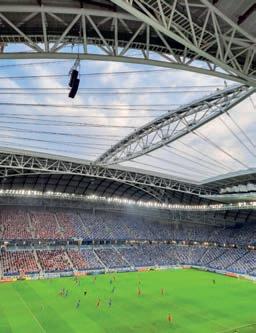
Stadium 974, Doha
The first temporary venue in World Cup history, the stadium is built from 974 recycled shipping containers. After the tournament, it will be dismantled. The design team included Fenwick Iribarren Architects and local outfit DCB, with Time Qatar as project manager and HBK as main contractor.

26 | CONSTRUCTION MANAGEMENT NOVEMBER/DECEMBER 2022 n Global constructionmanagement.co.uk
Ahmad Bin Ali Stadium, Al Rayyan
One of two stadiums in Al Rayyan, this 44,740-capacity venue was designed by BDP’s sports division Pattern Design, with Aecom as project manager. The construction team was led by Qatari firm Al-Balagh and Indian contractor Larsen & Toubro.

Education City Stadium, Al Rayyan

This 45,350-capacity stadium was designed by Fenwick Iribarren and BDP Pattern Design, working with Qatari project manager ASTAD and main contractor Conspel Qatar. It will later become a 25,000-seat student events venue.
Khalifa International Stadium, Doha
Previously Qatar’s biggest stadium, the Khalifa was constructed in 1976 and substantially renovated for the 2022 World Cup, now holding 45,416 spectators. The architect was Dar Al-Handasah, and the local construction team comprised main contractors Midmac, Porr and Six Construct, plus project manager Projacs.

Al Bayt Stadium, Al Khor

The World Cup’s second largest venue accommodates 60,000 fans. The design, by consultant Dar Al-Handasah, is inspired by the traditional tents of Qatar’s nomadic peoples and features a retractable roof. The contractor team included Italian firms Webuild and Cimolai, plus Omani outfit Galfar.
Al Thumama Stadium, Doha
Another stadium in the Qatari capital, Al Thumama will have its 40,000-capacity cut by half after the tournament. The design was created by OmaniQatari firm Ibrahim M Jaidah plus Korean architect Heerim. The main contractor team comprised local outfit Al Jaber and Turkey’s Tekfen.

CONSTRUCTION MANAGEMENT NOVEMBER/DECEMBER 2022 | 27 Global nconstructionmanagement.co.uk

Essential information for construction professionals constructionmanagement.co.uk Join 58,000 other construction professionals who subscribe to our newsletters by signing up here: constructionmanagement.co.uk/newsletter Keep up to speed with daily news, opinion, CPDs and technical info on CM’s website. Our content includes: l Breaking news l Technical articles for construction professionals l CPDs l BIM and digital construction coverage l Opinion from industry thought leaders l Legal analysis l Careers features CONSTRUCTION MANAGEMENT


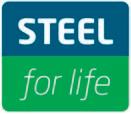

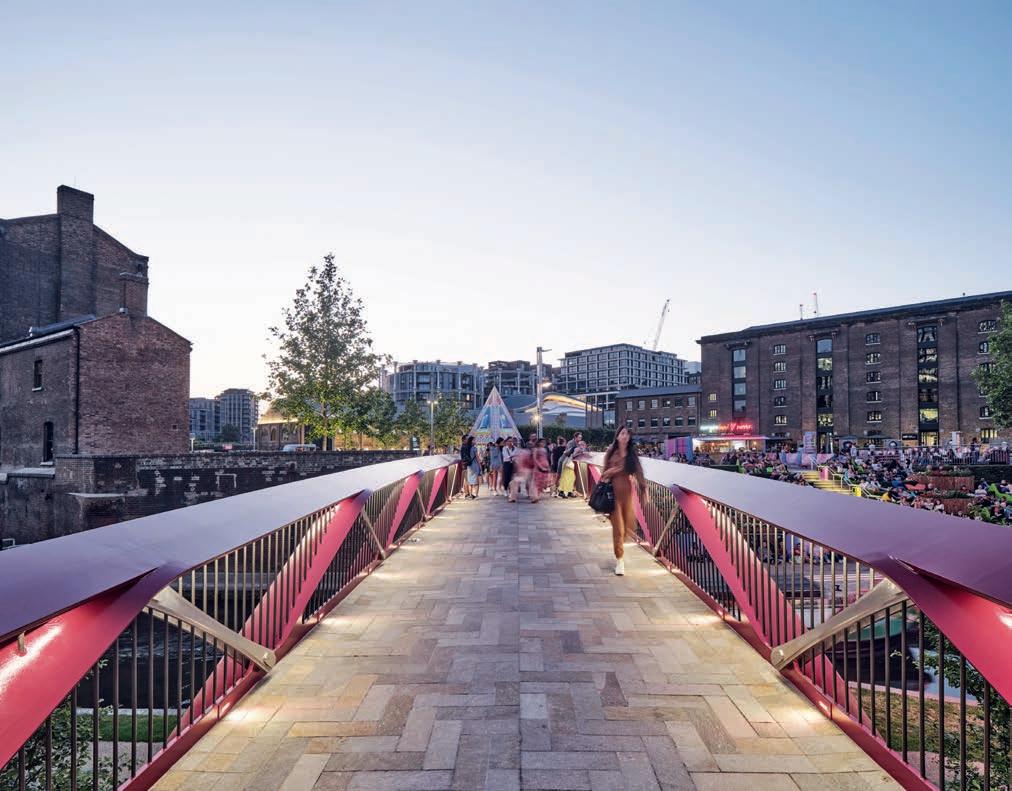

CONSTRUCTION MANAGEMENT NOVEMBER/DECEMBER 2022 | 29 HEADLINE SPONSORS Structural Steel Design Awards 2022 GOLD SPONSORS l Jamestown Manufacturing Ltd l voestalpine Metsec plc l National Tube Stockholders and Cleveland Steel & Tubes l Wedge Group Galvanizing Ltd SILVER SPONSORS l Barnshaw Section Benders Ltd l Ficep UK Ltd l Hempel l Tension Control Bolts Ltd l Voortman Steel Machinery
PHOTO: SIMON KENNEDY
For further information about steel construction and Steel for Life please visit www.steelconstruction.info or www.steelforlife.org Steel for Life is a wholly owned subsidiary of BCSA Produced by the BCSA and Steel for Life in association with Construction Management
IntroductionNow in their 54th year, the Structural Steel Design Awards highlight the variety, innovation and excellence of modern steel construction
The Structural Steel Design Awards (SSDA) have once again highlighted and rewarded many of the best examples of excellence, ambition and innovation in our built environment. Now celebrating their 54th year, the 2022 Awards, jointly sponsored by the British Constructional Steelwork Association and Trimble Solutions (UK), continue that great tradition.

The entries this year reflect the wide geographical spread of steel’s appeal for a variety of projects.
Projects entered for the scheme this year included large prestige city office buildings, educational facilities and beautifully designed footbridges. The judges were particularly interested in projects that reflected a reuse of existing structures and showed a commitment to lessening a project’s embodied carbon.
Twenty-one projects made the shortlist, from which the judges presented five awards, six commendations and four merits.
Unlike the last two years when the judges were unable to visit the projects due to COVID-19, no such restrictions were in place this year.
The SSDA’s cross-industry judging panel includes: chairman Chris Nash, Bill Taylor and Oliver Tyler representing the Royal Institute of British Architects; Richard Barrett representing the steelwork contracting industry; Paul Hulme representing the Institution of Civil Engineers; and Sarah Pellereau and Professor Roger Plank representing the Institution of Structural Engineers.
Super hangar checks in
The UK’s largest dual cantilever hangar has been completed at Biggin Hill Airport for aerospace company Bombardier
Famous for being one of the main Royal Air Force bases during the Battle of Britain, London Biggin Hill is today one of the fastest growing business airports in the UK.
Complementing a number of recent investments at the airport, a new Maintenance, Repair and Overhaul (MRO) hangar featuring a


dual cantilever has recently been completed for Bombardier. The hangar features two 160m clear span entrances, internal cranes for servicing aircraft, offices and a VIP lounge.

The project team say the early engagement of REIDsteel as the structural steel design and build fabricator, the hangar door
The cantilever truss design allowed a lower steel tonnage than conventional designs
30 | CONSTRUCTION MANAGEMENT NOVEMBER/DECEMBER 2022 n Structural Steel Design Awards constructionmanagement.co.uk
Produced by the BCSA and Steel for Life in association with Construction Management
Award: Bombardier Maintenance
Hangar, Biggin Hill
Architect: Civils Contracting Ltd
Structural engineer: REIDsteel
Steelwork contractor: REIDsteel
Main contractor: Civils Contracting Ltd
Client: Biggin Hill Airport Development Ltd
manufacturer and the cladding company significantly helped the successful completion of the scheme.
The company’s input was essential as steel elements needed to be erected and aligned on 45m-long cantilever trusses that had to accommodate complex hangar door head gear and underslung cranes.
After investigating traditional hangar solutions, a more costeffective design was proposed, which included a cantilever truss design for the hangar, conventional construction for the offices and an elegant, glazed lounge that has minimal bracing by virtue of the diaphragm within its roof structure.
The value-engineered cantilever design, along with load-sharing elements, allowed significant reductions in material use, producing a much lower steel tonnage at 1,600 tonnes compared with more conventional designs.
The design also allowed the roof of the hangar to safely span without support from internal columns, thereby achieving the client’s aspiration for two vast, unobstructed hangar floor spaces of 7,200 sq m each.
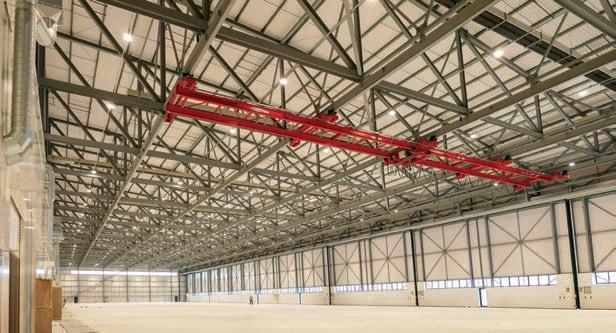
Long span cantilevers are said to be inherently vulnerable to disproportionate collapse, due to the nature of the tension connections in the top chord. To
The underslung cranes now have 100% coverage of both hangars
The central spine of the building anchors the cantilevers as well as housing the building’s functional spaces. The structure achieves remarkably good embodied carbon figures, in line with the LETI 2030 aspirational values
SSDA judges
alleviate this, and to help meet the stringent deflection criteria, loadsharing trusses were used to ensure that each frame could be supported by its adjacent frames.
This created a new issue, in that fabrication tolerances could cause a frame sitting higher than its neighbours to attract unacceptably high loads. The solution lay in leaving the load-sharing trusses ‘loose’ until all permanent loads were applied and only then tightening up the slotted preloaded bolted connections.
The design allows for the internal underslung cranes to have a 100% coverage of both hangars, rather than the previously proposed 50% of one, which has futureproofed the project.
The dual cantilever design also means the hangar can be extended to meet changing requirements over its 50-year design life.
Sustainability was a key consideration and a value-engineering exercise ensured that the final design used steel efficiently while also reducing the environmental impact.
The resulting reduction in steel weight was key in minimising the embodied carbon and saved 850 tonnes of CO2. The roof is designed to take solar panels and, assuming that the client achieves 50% coverage, this has the potential to save 300 tonnes of operational carbon per year. ●
CONSTRUCTION MANAGEMENT NOVEMBER/DECEMBER 2022 | 31 Structural Steel Design Awards nconstructionmanagement.co.uk
Steel delivers new stands at Lord’s

Forming part of Marylebone Cricket Club’s (MCC) ongoing masterplan to redevelop Lord’s Cricket Ground, two new stands have transformed the Nursery End of the arena

Positioned either side of the media centre, the new three-tiered Compton and Edrich stands have increased the capacity of the two stands from 9,000 to 11,600 seats. The redevelopment is said to have vastly improved sightlines, removing obstructed-view seats while creating new wheelchair
spaces and additional accessible seating – and adding a steel-framed roof, which partially covers the top tier.
“The design programme presented a significant challenge and we carried out a detailed design, programming and cost option study, which determined steel being selected for the main frame, where the initial project assumptions had been for concrete,”
explains Buro Happold senior project consultant Paul Eddleston.


“Sports projects typically need to respect the event calendar and this was no exception. Optimising the design for minimum construction time enabled the ambitious programme to be realised, although the programme developed during phase one of construction coincided
The scheme has provided new seating, greater accessibility and improved sightlines
32 | CONSTRUCTION MANAGEMENT NOVEMBER/DECEMBER 2022 n Structural Steel Design Awards constructionmanagement.co.uk
Produced by the BCSA and Steel for Life in association with Construction Management
Office scheme shows its steel
Trusses are left exposed in London’s One Crown Place
Award: Lord’s Cricket Ground, Compton & Edrich Stands Redevelopment

Architect: WilkinsonEyre
Structural engineer: Buro Happold
Steelwork contractor: Severfield
Main contractor: ISG Construction
Client: Marylebone Cricket Club
with the COVID-19 pandemic and the cancellation of spectator sports.”
In cross-section, the structures are predominantly supported on two main columns, with further support to the lower tier. The outer column is pin-ended to respond to the aesthetic requirement of presenting a lighter colonnade facade, while the inner column provides the lateral and longitudinal strength and stiffness.
To achieve this, the inner column is a 1,400mm x 500mm fabricated box with 100mm-thick base plates anchored with Macalloy bar assemblies. For aesthetic appeal, the steelwork is largely exposed in the completed structures. The design and detailing of the connections and splices needed to respond to these specific requirements as well as catering for the significant forces being transferred through them.
To develop the required structural stiffness, the terrace rakers were designed to be continuous through the main supporting column. This required them to be deep fabricated sections, while the back-span element was designed to gently taper to the outer facade to maintain the aesthetic brief for the external view. The roof is created by a series of curved, plated rafters located on primary grids, which in turn support the timber waffle and tensioned membrane covering.
The project was challenging in its complex architectural steelwork
A considered composition to complement the ground’s historic festival atmosphere, while accommodating spectators in style and comfort. The apparent easy symmetry belies the difficulties of planning sensitivities, timetable, site and ground constraints that were overcome SSDA judges
and very tight programme. There was less than a year for the old stands to be demolished, new piling and foundations installed, and the new stands built, before the start of the 2021 cricket season (later postponed due to COVID-19 restrictions).
“Offsite manufacture was a major benefit of using steelwork as it meant the erection of the stands could be done quickly and efficiently,” says Eddleston. “As there were many awkward interfaces between the steelwork rakers and precast terrace units, the use of BIM allowed the design team to ensure coordination in the 3D environment using the fabrication models for both prefabricated elements.”
The lead-in period was condensed further by a detailed value-engineering process, involving Severfield, ISG and the design team, which ensured the contract was as effective and cost efficient as possible – and ultimately ensured that MCC provided final sign-off for the project to go ahead. ●
For greater aesthetic appeal, the steelwork is largely exposed in the completed structures
Commendation: One Crown Place, London Architect: KPF

Structural engineer: AKT II Steelwork contractor: Severfield
Main contractor: Mace Client: AlloyMtd
A steel-framed podium forms the centrepiece for the One Crown Place mixed-use scheme in central London. The six-storey office podium, which is topped by a series of 15 steel trusses, supports two apartment blocks that reach heights of 33 and 29 storeys respectively.
The steel trusses, which are up to 25m long, perform three functions: first, they help to create the clear column-free internal office spans for the floors up to level six. Second, levels seven and eight are accommodated within their depth, where the truss elements are left exposed as architectural highlights.
Level seven accommodates a gym, a work hub, private screening room, meeting space and other exclusive amenities for the residents, while level eight is given over to apartments.
And third, they support the two reinforced concrete residential towers that begin at level nine. The trusses are supported at each end on 600mm x 600mm doublewebbed mega-columns, which were fabricated from four steel plates. All of the podium’s columns are founded at ground level, above a two-storey basement.
CONSTRUCTION MANAGEMENT NOVEMBER/DECEMBER 2022 | 33 Structural Steel Design Awards nconstructionmanagement.co.uk
PHOTO: HUFTON AND CROW
King’s Cross connection
Providing a link across the Regent’s Canal, the 25m-long Esperance Bridge has an elegant and sculptural form created with tapering and folded steel plates
eaturing a host of highquality finishes, such as bespoke balustrades and drainage channels, Esperance Bridge is a simply supported Warren truss made of welded steel plates with a steelconcrete composite deck.
The reinforced concrete deck controls the dynamic behaviour and acts compositely with the steel to carry the deck loads to the trusses.

The top chord flows into the diagonal compression struts and continues around the bathtubshaped structure to terminate at a longitudinal stiffener centred under the deck. Using this design,

the flange provides improved buckling capacity for the struts and simultaneously restrains the top chord.
Fairing plates complete the expression of flow of forces from the top chord, down the diagonal struts and along to the bottom chord. Finally, the ties are stainless steel, expressing their differing function and reducing their visibility to emphasise the repeating truss module.
Recognising that the built environment has a critical role to play in reducing carbon emissions, the project team reused the existing Goods Way retaining wall on the south side of the bridge.
The bridge’s complex curved shapes offered a challenging delivery
This was made possible with local modifications and helped the final design for the footbridge to achieve a 20% carbon saving compared to a traditional build.
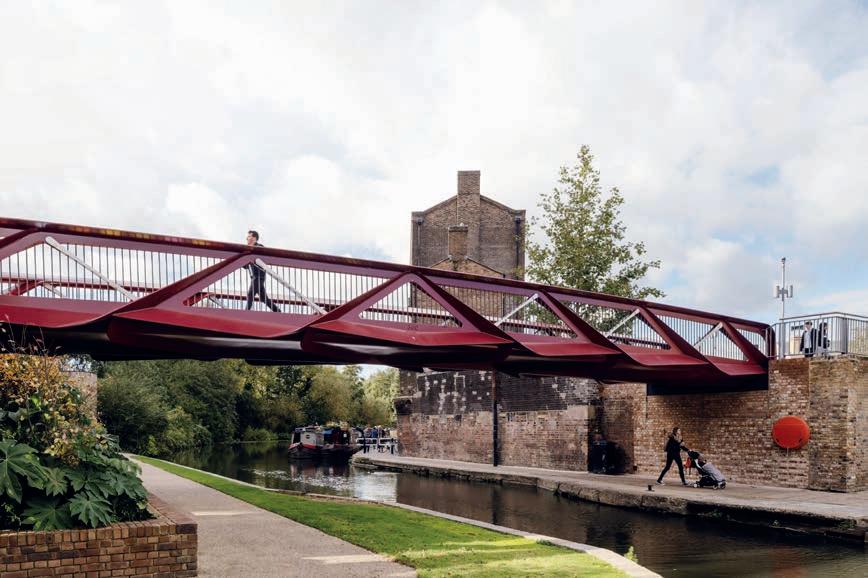
The definition of the geometry and the fabrication of the superstructure was challenging due to the complex curved shapes. The project delivery model had a period of early contractor involvement, which brought designer, architect, main contractor, quantity surveyors and steelwork contractor together at an early stage to define key details that were practical to fabricate.
The use of 3D models to review difficult details allowed for a more

34 | CONSTRUCTION MANAGEMENT NOVEMBER/DECEMBER 2022 n Structural Steel Design Awards constructionmanagement.co.uk
Produced by the BCSA and Steel for Life in association with Construction Management
PHOTOS: SIMON KENNEDY F
Award: Esperance Bridge, King’s Cross
Architect: Moxon Architects
Structural engineer: Arup Steelwork contractor: S H Structures Ltd
Main contractor: Galldris
Client: Argent
effective collaboration. With key details established, a mock-up of a standard truss module was produced to test the fabrication and to confirm the visual appearance of the most important plate interfaces. This allowed the team to hone visual details and push the fabrication and workmanship skills to the highest standard. While complex, the modular nature of the truss form allowed a high degree of repetition, eventually streamlining both design and fabrication.
The curved plates were formed before being welded into the final assembly by the steelwork contractor. The bridge steelwork was fully fabricated offsite,
providing greater control on quality and ensuring minimal disruption to an active and congested site. For the installation process, the completed bridge was lifted over the canal in one piece.
“This exceptional design perfectly captures the proud heritage of the area that defines the development. A special thanks to our key partners that meticulously worked through every detail of the design without compromise, and to the delivery team that ensured the bridge was expertly manufactured and installed to sit perfectly across the canal,” says King’s Cross Central Limited Partnership development manager Ben Cooper. ●
An elegant, pragmatic solution that is carefully crafted and beautifully made, its design appropriately reflecting the site’s industrial heritage.
Thoughtful detailing of the curved steelwork to create the threedimensional sculptural balustrade fully exploits the properties of steel and the potential it offers SSDA judges
Flexibility is fit for purpose
Steel’s strength and lightness was needed for a sports hub
The project reused the existing Goods Way retaining wall on the south side of the bridge
Commendation: Britannia Leisure Centre, Hackney Architect: FaulknerBrowns Architects
Structural engineer: Buro Happold Steelwork contractor: Severfield
Main contractor: Morgan Sindall Construction Client: Hackney Council

Part of a multi-million-pound scheme that will transform an area bordering Shoreditch Park in east London, the new Britannia Leisure Centre utilised a stacked steel design to deliver its facilities within a tight footprint.
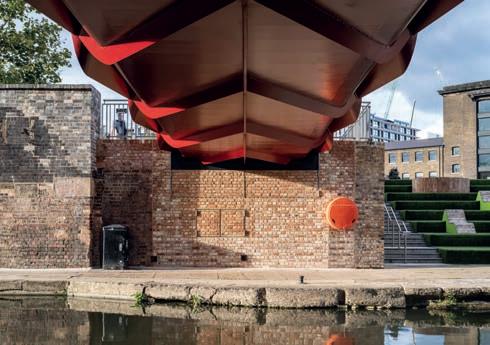
To this end, the centre has a variety of column-free areas, some of which are double-height and triple-height zones, positioned on top of or adjacent to each other, like a collection of different-sized boxes.
It accommodates extensive wet and dry facilities including a six-lane 25m pool, a training pool, leisure water, a sports hall, fitness suites, rooftop pitches, squash courts and a cafe. The client aims to create a hub that encourages participation in an active lifestyle.
Despite the pandemic, the centre has welcomed 400,000 visitors in its first six months, a 161% increase from the centre that it replaces.
The project team say steelwork was the only material that could form the centre’s spans of up to 40m, remain light enough to manoeuvre into position and work within the site’s tight constraints.
CONSTRUCTION MANAGEMENT NOVEMBER/DECEMBER 2022 | 35 Structural Steel Design Awards nconstructionmanagement.co.uk
Reused and rebuilt
A 1990s London office block has been refurbished and enlarged to create an exemplary sustainable and healthy workplace
ormerly a headquarters building for the First National Bank of Chicago, 1 Triton Square is a prime example of the increasing trend to refurbish and enlarge existing office blocks as a cost-effective and sustainable alternative to demolition.
Opened in 1997, this concreteframed office building was the
first structure to be completed at Regent’s Place, a 5.26ha fully managed mixed-use campus on the north side of London’s Euston Road.
Lendlease project director Chris Carragher says the decision to refurbish the building instead of demolishing it was all about creating the most sustainable construction solution possible and is testament
The new ninestorey building is centred around the reconfigured atrium

Award: 1 Triton Square, London
Architect: Arup Associates
Structural engineer: Arup
Steelwork contractor: William Hare Ltd



Main contractor: Lendlease Client: British Land
to British Land’s sustainable values.
“Refurbishing a project is a more environmentally friendly option, as well as being cost-effective,” he says.
Further highlighting the benefits of the chosen construction method, a 43% cost saving was made compared to a typical commercial building job, while overall it was 30% quicker to complete.
Arup’s structural lead Andrew Robertson adds: “About 35,000 tonnes of concrete and 1,900 tonnes of steel have been reused and saved from demolition. The reuse of the structure and facade elements has resulted in carbon savings equivalent to a gas and electricity emission-free operation for 26 years.”
The existing five-storey building has been extended upwards with the addition of three new steel-framed office floors and a rooftop plant level. Meanwhile, an unusually large 36m-wide atrium has been partially infilled with one new bay of steelwork all the way around, creating more office space for each of the existing floors and a smaller but still impressive 18m-wide atrium space.
Steelwork for the new upper floors is based around a 9m column grid pattern, in line with the existing structure’s layout. For the new infill floor areas inside the atrium, a series of long beams create an open-plan floor area.
The new nine-storey building is now centred around the reconfigured atrium, which will
36 | CONSTRUCTION MANAGEMENT NOVEMBER/DECEMBER 2022 n Structural Steel Design Awards constructionmanagement.co.uk
Produced by the BCSA and Steel for Life in association with Construction Management
PHOTOS: SIMON KENNEDY F
provide links between floors via internal feature staircases.
All of the new steelwork for the scheme is either founded on the existing steel cores or off the existing main frame. Within the atrium, the existing structure was cut and carved down to the basement to allow lift pits and a ground slab to be constructed, from which the new steelwork was erected.
The new scheme has resulted in the existing structure being exposed to significant increases in loading. As a result, prior to steelwork contractor William Hare beginning its package, Lendlease had to undertake preliminary works that included strengthening existing concrete columns as well as installing 180 new piles in preparation for the new steelwork. This early work also included the removal of a steel-framed glazed roof that covered the atrium.
The addition of three new storeys translates to a significant increase in the horizontal loads on the building. Despite the new scheme making
An exemplar of sustainability thanks to the use of steel. It demonstrates how an existing building can be almost doubled in floor area, for a fraction of the embodied carbon of a new building the same size. The achievement was a clear team effort where all options and details were scrutinised to meet the client’s tough brief SSDA judges
use of the existing frame to take some of these stability loads, the capacity of the existing bracing system was exceeded.
Therefore, before starting to add the new steelwork to the cores, the existing diagonal braces were sequentially replaced so they could accept the additional loads.
British Land set high sustainability aspirations for 1 Triton Square. The project was awarded a BREEAM Outstanding rating and has been named one of the UK’s most sustainable HQs. ●
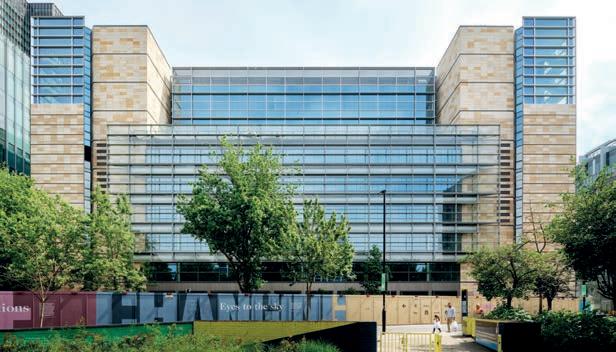
Three steelframed office floors have been added to the building
Keeping the weather out
Bristol landmark offices are 40% more thermally efficient

Commendation: Assembly Bristol, Building A Architect: Allford Hall Monaghan Morris
Structural engineer: Arup Steelwork contractor: Severfield Main contractor: Galliford Try Clients: Bell Hammer, AXA IM
Immediately recognisable for its exposed green-painted steel frame, Assembly Building A is a landmark commercial office and associated public realm adjacent to the Floating Harbour in Bristol city centre.
Spread across 13 floors, the structure is 120m-long x 25m-wide, and consists of a steel frame on a 9m x 12.5m grid, with a composite floor slab on trapezoidal metal decking.
A key innovation was designing out the thermal breaks. This was achieved by using fabricated I-sections for the steel stubs that penetrate the facade, allowing the flange and web thicknesses to be optimised and justified through 3D thermal modelling and advanced structural analysis.
This resulted in a deceivingly simple solution that was thermally 40% more efficient than the traditional approach and eliminated 270 thermal breaks together with associated fabrication, installation and weather sealing complexity.
Achieving BREEAM Excellent, the building’s steelwork is exposed both internally and externally, with connections that have been carefully detailed to ensure visual consistency and elegance.
CONSTRUCTION MANAGEMENT NOVEMBER/DECEMBER 2022 | 37 Structural Steel Design Awards nconstructionmanagement.co.uk
Tower of power
Adorned with laser-cut steel plates, a 40m-tall tower that supports five flues is a key component of a city-centre combined heat and power energy centre
elping to improve the city’s air quality, Manchester’s Civic Quarter Heat Network project will supply several local buildings with low-carbon energy much of which will be derived from a new combined heat and power (CHP) energy centre.
Alongside the environmental benefits, the CHP’s city-centre
location meant the client wanted the facility’s five flues housed within a structure with some architectural merit.
To satisfy this brief, the flues are accommodated in a 40m-tall steel tower, which has a curved perimeter shell and is known as the Tower of Light. The shell is tailored from 6mm and 8mm-thick laser-cut steel
The tower was fabricated as a series of nine modules which were then stacked on site
Award: Tower of Light, Manchester

Architect: Tonkin Liu
Structural engineer: Arup



Main contractor: Vital Energi
Client: Manchester City Council
plates, which have been curved and welded together to create a stiff, strong surface. The geometric stiffness is provided by the curves, folds and corrugations in the shell that enable the thin steel plates to resist buckling without the need for any additional stiffeners.
The geometry of the shell’s corrugations and perforations was developed using digital workflows to identify a structurally optimal form. Parametric tools were used to quickly generate and analyse several variations of the geometry, which allowed the design team to study the effect of changes in the form of the shell on the buckling and fatigue performance of the structure.
“Designing and fabricating the complex geometry of the unique structural steel perimeter shell of the tower was very challenging,” says Arup structural engineer Chris Clarke. “A structural shell of this form and scale could not have been formed in any other material, so the use of steel was integral to the realisation of the tower.”
The perimeter shell structure has the dual purpose of also acting as the facade of the tower. Using the same material to provide both the structure and the facade had a material efficiency benefit over a more conventional braced frame flue tower, which would require a non-structural facade system. A study to compare the embodied carbon of the shell
38 | CONSTRUCTION MANAGEMENT NOVEMBER/DECEMBER 2022 n Structural Steel Design Awards constructionmanagement.co.uk
Produced by the BCSA and Steel for Life in association with Construction Management
PHOTOS: DAVID VALINSKY H
Curved steel plates were welded together to create a surface that resists buckling
tower with a more conventional flue tower showed that the embodied carbon of this project was lower, with a vastly reduced number of components.

Due to the high number of edges and corners in the tower, there was a risk that a painted corrosion protection system would not be sufficiently reliable. Therefore, stainless steel was selected for the tower shell to ensure excellent durability. The tower is painted white for architectural reasons, but this also allowed a lower grade of stainless steel to be used and avoided expensive surface treatments, thereby reducing the project costs.
A series of decks at 4m intervals up the height of the tower support the flues and transfer their loads back to the tower shell. The decks also enable access and maintenance of the flues and have been designed with removable panels to facilitate replacement of the flues if required.
In total, the tower was fabricated as a series of nine modules. Once fabricated, modules were transported to site, stacked on top of one another and fixed together by internal preloaded bolted flange connections at the top and bottom of each module.
Flue sections were pre-installed in each of the modules prior to lifting. These flue sections were then connected when the construction of the tower structure was complete. ●
Exemplifies the synthesis of striking architectural form, advanced engineering, iterative technical analysis and craft-based fabrication. A superb example of how design can transform a utilitarian chimney into a piece of urban art, intelligently conceived and impressively executed SSDA judges
Steel sings in Sunderland
Commendation: Fire Station Auditorium, Sunderland Architects: Flanagan Lawrence, Howarth Litchfield
Structural engineer: JC Consulting Main contractor: Brims Construction Ltd Client: The Sunderland Music, Arts & Culture Trust
The Fire Station Auditorium project has delivered a new multifunctional destination for music and culture in Sunderland city centre.
The auditorium is a flexible space and suitable for multiple performance types, allowing a quick transition between events to maximise the use of the venue.
After being initially designed as a reinforced concrete box containing some steel elements, a value-engineering exercise was undertaken, whereby the design was switched to an entirely steelframed project, which resulted in a saving of approximately £300,000.
The use of steelwork to form a double cantilever is key in creating the architectural inside/ outside intent of the structure’s main facade. The steel members cantilever internally to support the first floor around the atrium as well as externally to support the main facade and roof.
Flexibility within the auditorium is provided by multiple stage positions, and numerous seating and standing arrangements. This is complemented by collapsing handrails, moveable stairs and retractable seating.

New music venue features double steel cantilever
CONSTRUCTION MANAGEMENT NOVEMBER/DECEMBER 2022 | 39 Structural Steel Design Awards nconstructionmanagement.co.uk
PHOTO: DAVID ALLAN
New growth at RHS Wisley
Lightweight atrium frame enables flexible use of building
Commendation: Central Atrium at Hilltop, RHS Wisley Architect: WilkinsonEyre

Structural engineer: Michael Barclay Partnership LLP


Steelwork contractor: Hillcrest Structural Ltd

Main contractor: Osborne Client: Royal Horticultural Society
Adding to the attractions at the Royal Horticultural Society (RHS) Garden at Wisley, a steelframed and sustainably designed education and science centre has been opened.
The building is ‘Y’ shaped in plan, a form designed to integrate with the landscape and encourage visitor flow through the building and surrounding gardens. It is divided into two functional wings linked by a central atrium.
At ground level, the atrium acts as a flexible public engagement space and provides the public with access to the cafe, events space, classrooms and library. At first floor level, via cantilevered walkways and a bridge, the atrium space links more restricted access areas such as laboratories and offices.
The north end of the atrium forms the main entrance to the building and opens out onto long views across the site.
A steel frame was selected to achieve a lightweight, filigree and curved grillage that could be detailed to incorporate drainage, ventilation, movement and thermal separation.
Overall, the atrium structure relies for its lateral stability on the adjoining wings but, since the atrium is subject to a different thermal environment, movement joints have been incorporated into the design.
Steel makes the City slicker
One Braham maximises space and minimises vibrations
Commendation:
One Braham, London Architect: WilkinsonEyre
Structural engineer: Arup Steelwork contractor: Severfield Main contractor: McLaughlin & Harvey Client: Aldgate Developments
With a BREEAM Excellent rating, One Braham is a prestigious commercial development that forms part of a wider Aldgate masterplan.
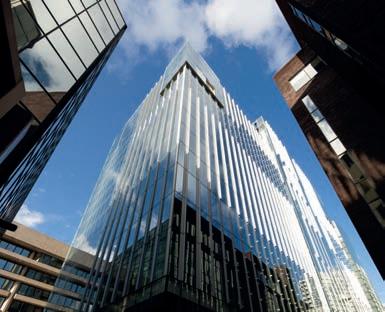
The structure offers 27,700 sq m of office space across 19 floors, including two large open terraces on the 15th and 17th floors, while at ground level there are two retail units.
The building’s facades are fully glazed with vertical brisesoleils on the east, south and western facades. The ground
floor is set back to form a colonnade between a new park, the building’s double-height entrance and adjacent shops.
From ground level upwards, the structure has floors comprising metal decking with exposed soffits and an insitu concrete topping that acts compositely with the steel plate girders to maximise strength and stiffness. The mobilised mass also helps to minimise floor vibrations from the tenant’s footfall.
To create the client’s requested industrial aesthetic in the office spaces, much of the internal steelwork has been left exposed.
The internal plate girders have bespoke holes to allow all the services to be accommodated within their depth. This service integration and the use of shallow heavy plate girders allowed one extra floor to be incorporated into the scheme.
40 | CONSTRUCTION MANAGEMENT NOVEMBER/DECEMBER 2022 n Structural Steel Design Awards constructionmanagement.co.uk
Produced by the BCSA and Steel for Life in association with Construction Management
PHOTO: MEDIAMIXER NEW MEDIA
Portsmouth canopy shelters D-Day vessel
Merit: LCT 7074 Canopy, The D-Day Story, Portsmouth Architect: Pritchard Architecture Structural engineer: Mann Williams Steelwork contractor: Hillcrest Structural Ltd Main contractor: Ascia Construction Ltd Clients: The National Museum of the Royal Navy, Portsmouth City Council
Part of the D-Day Story museum on Southsea (Portsmouth) seafront, this cantilevered steel canopy showcases the conservation of the sole surviving landing craft tank (LCT) from the D-Day landings on 6 June 1944.
The canopy required an elegance and simplicity that is empathetic to its sensitive surroundings, while maintaining a presence that physically relates to the robustness and mass of the ship itself. Structural steelwork provided an efficient and cost-effective design solution for the structure, owing to its high strengthto-weight ratio, which facilitated the slender yet robust form.
The canopy is supported on one side by 12 bespoke tapered fabricated mast columns, each 12m-tall and weighing 7.5 tonnes, formed from 25mm-thick plates. The columns align with the piers of a historic wall, keeping one side of the ship clear of visual distraction and providing uninterrupted views of the vessel from the roadside.
Signposting the benefits of renewable energy sourced from the River Ness, the Highland Council’s Hydro Ness scheme also informs young people about science, technology, engineering and mathematics (STEM) skills.

Steel stair on show at Pace Gallery
Merit: Pace Gallery, Hanover Square, London Architect: Jamie Fobert Architects Structural engineer: Price & Myers

Main contractor: QOB Interiors Client: Pace Gallery
A central London gallery has been reconfigured to become the new home of the Pace Gallery, a leading international art exhibitor.
Construction included the creation of two new galleries on the first floor and an opened-up basement level that creates a third 100 sq m public volume.
The three new galleries are highly flexible, allowing the Pace team to show various types and scales of art by adding or removing internal walls and covering or revealing windows.
A sculptural steel staircase links upper and lower spaces, allowing sunlight to pour into the basement offices. The stair is fabricated from waxed raw mild steel, showing the colours of the heat marks and manufacturing processes. Its development involved close collaboration with the architect, engineer and steelwork contractor.
Hydro Ness hub stays a leap ahead
Merit: Hydro Ness, Inverness
Architect: Leslie Hutt Architect Structural engineer: Hasson Engineering Solutions
Steelwork contractor: M Hasson and Sons Ltd
Main contractors: Bradley and Company, Hydro NI Client: Highland Council
As well as generating renewable electricity and reducing carbon emissions, it provides an interactive experience and a learning hub for climate change, local ecology, engineering and renewables.
Housed within a curved steelframed canopy, the building’s shape is inspired by a salmon making its way upstream.
The frame comprises steel sections curved to differing radii. Most of the structural steelwork was galvanized to ensure longevity.
The cladding panels – framed with SHS welded into co-planar triangles – are stainless steel with a swirl finish to enhance the intention of ‘looking like scales of a fish’.
Former radio site broadcasts quality
Merit: Houlton School, Rugby Architect: Van Heyningen and Haward Architects
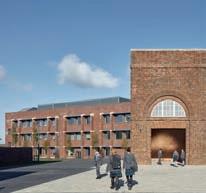
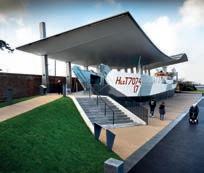
Structural engineer: Price & Myers
Steelwork contractor (new blocks): Mifflin Construction Ltd
Main contractor: Morgan Sindall Construction Client: Urban&Civic plc
Steel construction has allowed historically significant radio station buildings in Rugby to be retained and converted into the new Houlton School. The site previously hosted the first transatlantic telephone call to New York, transmitted telegraph messages to the Commonwealth and communicated with nuclear submarines during the cold war.
A new steelwork frame was threaded through the first floor of the existing Transmission Block to provide an additional four floors of accommodation, while leaving the existing first floor steel beams exposed and intact.
To improve circulation, two steelwork scissor stairs have been constructed at each end of the Transmission Block and ring beams added to restrain the existing walls around the new stair voids. Two further steel staircases are inserted into the adjacent Accommodation Block. External openings have been adjusted in the Power Hall to suit its new use as a dining and main hall.
CONSTRUCTION MANAGEMENT NOVEMBER/DECEMBER 2022 | 41 Structural Steel Design Awards nconstructionmanagement.co.uk
PHOTO: MATT CLAYTON
PHOTO: KEITH HUNTER
PHOTO: JAMES BRITTAIN
PHOTO:
PETER
LANGDOWN


The benefits of cloud-based working
Keeping important data and digital tools in the cloud enables construction project teams to work anywhere and can save time and money. James Chambers explains


As construction continues to digitise, robust, cloud-based solutions are essential. Solutions include file storage, communications platforms, software tools and company networks and databases.
A significant amount of time and money can be saved by having these tools in the cloud, with project teams able to work anywhere, at any time and with the information and software they need.
Making work more accessible These services are ready from the moment a user logs in, often customisable around the specific needs of companies and individuals
and underpinned by regular updates and support. Because storage is cloud-based too, companies are not restricted by server access or performance. Even poor connections are not a problem, with most cloudbased tools offering an offline mode, allowing even the most remote project teams to work effectively together.
Managing via the cloud Cloud-based working also makes it easier for businesses to manage their licences and users; by removing the constraints of time, cost and distance, it is easier to bring together the right team for the task.
And it allows companies to use a broader range of devices, with
In association with
many tools and apps able to work seamlessly across desktop and mobile without any problems when it comes to transferring information.
Improving teamwork
Teams can work both in real time, via virtual meetings or in-software, or on demand, with people working on shared files and using email and chat to communicate. This makes it easier to keep teams synchronised and on top of the latest documents and progress, helping with collaborative tasks like cost and design reviews.
Most tools can be easily connected by APIs too, so it is not the case that people are stuck within their existing systems. At the SME level, this can be a worry as companies do not want to reinvest the time, cost and energy to overhaul systems and workflows.
Risk management in the cloud Using technology like this creates a wealth of data and a real-time audit trail of project activities, helping organisations manage risk. Changes to guidance and legislation, such as the Building Safety Act, make this essential; teams must have evidence for how they manage workflows.
One area of caution: as with any technology, there is a cyber security risk, especially considering the breadth of the supply chain that may have access to systems and data. Companies must have effective security, both on the serviceprovider side and at device level, and communicate with users to explain the principles of effective cyber security.
To see how cloud-based working could benefit you, download a free trial of Bluebeam Revu: https://support.bluebeam.com/ bluebeam-studio-getting-started. ● James Chambers is director, global industry development, Bluebeam.

44 | CONSTRUCTION MANAGEMENT NOVEMBER/DECEMBER 2022 n Partnership constructionmanagement.co.uk
By removing the constraints of time, cost and distance, it is easier to bring together the right team for the task
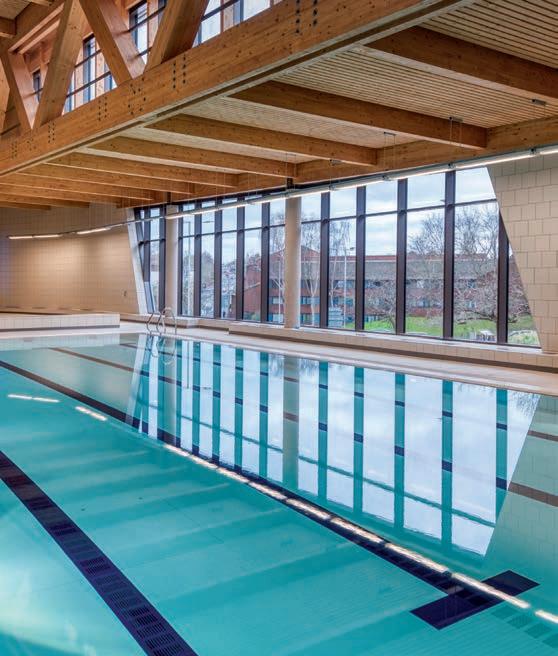
constructionmanagement.co.uk 31,416* The largest circulation of any UK construction magazine. 55,000 Email newsletters reaching CIOB members and other construction professionals. Unparalleled access to the key decision makers leading the UK construction industry. CIOB AWARDS CONSTRUCTION MANAGEMENT OCTOBER 2022 | WWW.CONSTRUCTIONMANAGEMENT.CO.UK CONSTRUCTION MANAGEMENT CIOB AWARDS | SUPPLY CHAIN ETHICS CPD | HEAT PUMP MYTHS DISPELLED constructionmanagement.co.ukOCTOBER 2022 MAKING A SPLASH HOW THE CONSTRUCTION MANAGER OF THE YEAR DELIVERED THE UK’S FIRST PASSIVHAUS LEISURE CENTRE 01.CM.Oct22.cover.indd 1 17/09/2022 12:42 CONSTRUCTION MANAGEMENT *ABC audited July 2021 to June 2022
Refurbishing concrete multi-storey car parks

The UK has an ageing stock of multi-storey car parks (MSCPs), many of which were constructed from reinforced concrete in the 1960s and 1970s. A large number have exceeded their design life and require increasing levels of investment to operate. This CPD, in association with Sika, looks at the causes, indicators and solutions to structural defects in MSCPs
Although there are examples of well-built, well-maintained car parks, many in the UK have structural defects due to issues with design, materials and workmanship, all of which have been exacerbated by years of neglect and the increased demands placed on them by owners and operators.
In many cases, the maintenance and repair approach for these structures has been to patch up visible damage as cheaply as possible and carry on, rather than adopting a whole-life maintenance strategy. This reactive maintenance does not always ensure that car parks are maintained to a good
46 | CONSTRUCTION MANAGEMENT NOVEMBER/DECEMBER 2022 n CPD constructionmanagement.co.uk
In association with
Reactive maintenance, without treating the causes of the deterioration, can result in the need for much larger and more expensive interventions when maintenance issues snowball
state of repair and without treating the causes of the deterioration, can result in the need for much larger and more expensive interventions when maintenance issues snowball.
The cost of these repairs is exacerbated by the full or partial closures they entail, which have the knock-on effect of reducing footfall for surrounding businesses. The damage can be long lasting as valuable customers are lost to ‘competitor’ car parks.
Increased loads in car parks

The ongoing challenges of this legacy are compounded by the shift to electric vehicles (EVs), which are heavier than internal combustion (IC) engine vehicles due to their batteries, the armour required to protect them and the reinforced chassis and suspension required to support the battery weight.
Many of the UK’s car parks were built when cars were significantly smaller and lighter than current models, even before factoring in the shift to electric vehicles. The increased load is significant – Sika’s research shows there is a 148% vehicle weight increase when comparing the top five selling cars of the 1960s with the top five selling EVs in 2021.
Inevitably, if you increase the weight of the vehicles using an MSCP, then both the dead/static loads (self-weight of the structural concrete elements, fixed items and
parked cars) and live/dynamic loads (moving cars, people) increase and so do the corresponding stresses they place on the structure, even if the number of vehicles does not.
What to look for The objective for any car park operator is to ensure that car park structures are safe, structurally sound and fit for purpose. This will involve taking stock of the asset in its current state, before looking at what needs to be done to strengthen and repair the structure. Once works are complete, there then needs to be a plan put in place to ensure that the asset is maintained into the future.
Visual indicators of structural deterioration can include: l Water seepage: Water/rust staining of beam sides and deck soffits, often including the formation of stalactites, may indicate failed waterproofing, movement joints or drainage and may present an increased potential for corrosion damage and coating failures.
CFRP plates and wraps
PROS
Lightweight
Uniform
Very
Will
Straightforward
Can be hidden behind mortars,
CONS
coatings
Proactive maintenance is important to prolong a car park’s operational lifetime
Cracking in concrete may be an indicator of ongoing structural issues

l Concrete cracking: There are myriad causes but cracking could indicate ongoing structural issues –and allows contaminated water to reach the steel easily. It can often be worsened by thermal expansion/contraction.
l Spalled concrete with exposed steel reinforcement: This arises from expansive corrosion products (rust) forcing the concrete cover to fail. The corrosion is caused by de-icing salt ingress (decks or wet areas) or carbonation (acidification) of the cover concrete, typically in drier areas.
l Deck coating wear and tear: Patches where coatings are delaminated or worn through due to application issues or tyre abrasion. Failed coatings lead to water ingress.
Steel plates or beams
More widely understood and remain the most common
design
Lower
Simple
to move into position and may need propping (which would cause closure of area below)
Adds significant static loads to structures
Require ongoing painting and inspection/maintenance
Point loads due to fixings and maximum length circa 5m Cannot be fixed through or to Reduced ceiling heights (beams) and increases width of columns
Higher
Fire resistance (only in certain circumstances)
Liable to corrosion
CONSTRUCTION MANAGEMENT NOVEMBER/DECEMBER 2022 | 47 CPD nconstructionmanagement.co.uk
PROS
with very little manual handling risk
method, using common
codes
application of strengthening (no bolts)
material/fabrication costs
little impact on headroom or column width
surface preparation
not corrode CONS
and quick installationHeavy
renders or
initial cost
Presenting the solution
Fortunately, there are a host of innovative products and systems to ensure that car park structures can be returned to a good state of repair, while also allowing them to cope with the increased weight of EVs. It is recommended that stakeholders follow a four-step process: assess, specify, repair, maintain.
1. Assess
Assess the structural performance of existing structures to reflect their current condition, current loadings and future loadings. This is typically carried out by a structural engineer.
Undertake a concrete condition assessment to quantify any damage and deterioration to structural elements, identify their causes and determine their extent and seriousness (usually a combination of chloride sampling/analysis, half-cell potential mapping, cover depth and carbonation depth surveys etc). This is typically carried out by a specialist surveying and testing contractor.
Sika’s research shows there is a 148% vehicle weight increase when comparing the top five selling cars of the 1960s with the top five selling EVs in 2021
The incredibly high strength of the carbon fibres, along with their low weight, means that much less material is required to achieve the same level of strengthening as steel
This initial testing will allow the specifying engineer to determine any issues to be addressed. The results will also allow for prioritisation, to ensure that ‘big ticket’ items critical to the car park remaining open are addressed as a priority.
2. Specify
It is therefore essential that the responsible engineers engage with materials manufacturers and suppliers to ensure that the correct products and product systems are specified for the project.
Reinstate lost strength
There are myriad product categories that can be used to reinstate the strength of a car park structure which has been lost through corrosion damage, structural movements and excessive loading.
These include reinforcement primers, structural repair mortars and grouts, resin anchors and crack injection resins. These repairs may require new reinforcement to be installed to replace bars damaged by reinforcement corrosion.

The idea behind these kinds of repairs is that defective concrete is replaced by a durable material that is at least as strong as the existing concrete. This allows load paths to be reinstated and further deterioration to be stopped.
CFRP plates are fitted to provide extra support to a beam
When this is done successfully, the products and systems will address most, if not all, of the issues raised by the testing and surveys carried out. This ensures that the repairs have the longest possible lifespan and therefore represent a sound return on investment.
3. Repair
The standard that governs the assessment and repair of concrete structures is the BS EN 1504 series: Products and Systems for the Protection Repair of Concrete Structures. This sets out the principles to be followed for a highquality durable repair and should be the basis of any repair intervention.
Broadly, the techniques and products used to structurally repair a car park structure fall into three categories: Reinstate lost strength, protect against future deterioration and increase strength.
There are subsets of products within these categories that are particularly useful in car park repair works. Fast-set, rapid strength gain products, usually but not always based on epoxy technology, can ensure a return to trafficable surfaces within a few hours post-repair.
Protect against future deterioration
Concrete protection in some form is often required in MSCPs to ensure the longevity of the structural concrete, including any repairs that have been made. These products generally fall into one of two categories: l Corrosion control, to mitigate the risk posed by chloride ions in the concrete. Cathodic protection and prevention techniques use activated zinc or hybrid anodes to relocate the corrosion reaction to the anode and prevent reinforcement corrosion. In addition, corrosion inhibitors can be used to stop or prevent corrosion. l Ingress prevention, to prevent water penetrating into the concrete. On the car park decks and column
48 | CONSTRUCTION MANAGEMENT NOVEMBER/DECEMBER 2022 n CPD constructionmanagement.co.uk
148
bases, high-strength, waterproof and wear-resistant coatings prevent water laden with chloride salts from penetrating the concrete and causing reinforcement corrosion. On the columns, beams and soffits, coatings are also used to prevent moisture from entering, but also to prevent carbonation of the concrete, a process which leads to reinforcement corrosion. Hydrophobic impregnants are another class of material which line the pores of the concrete, preventing water ingress. These can be applied to the concrete surface in either liquid or cream form.
Increase strength
To ensure that the various elements of the car park can withstand current and future loads, it may be necessary to supplement their strength and load-bearing capacity. Traditionally, this has been done using various forms of steel to supplement the reinforcement already buried in the concrete: for example steel plates, steel reinforcement in a concrete ‘jacket’
around columns, or by adding supplemental beams to the soffit.
While these techniques, when properly designed, undoubtedly achieve the aims of the strengthening, they increase the self-weight and therefore static load on the car park. Also, as they all contain ferrous materials, they represent a corrosion risk which must be mitigated by coatings and regular inspection and maintenance.
A proven alternative, carbon fibre reinforced polymer (CFRP) products have been successfully employed for 30 years or more to strengthen reinforced concrete structures. These materials generally come in the form of pultruded plates or as uni- or multi-directional fibres. These are then combined with an epoxy resin or adhesive on site to create a composite strengthening system.

The incredibly high strength of the carbon fibres, along with their low weight, means that much less material is required to achieve the same level of strengthening as steel. A steel plate 10mm+ in thickness, weighing
Carbon fibre reinforced polymer (CFRP) fabrics can strengthen weakened concrete CFRP fabric can be wrapped around a concrete column to provide strengthening

100kg+, can be replaced by a ~1mm thick plate of CFRP weighing only a few kg. Similarly, a reinforced concrete column jacket 150mm thick can be replaced by several wraps of a CFRP fabric which might total just 10mm.
The weight reduction alone reduces the risks around manual handling and the amount of labour required on site, and removes the need for lifting/propping equipment.
In addition, lengths of up to 50m can be applied in one go and there is no risk of corrosion.
4. Maintain
Once repairs and strengthening are complete, it is important to maintain the structure to prolong its operational lifetime. Car park owners can refurbish their existing assets for a fraction of the cost of new build, while also preventing the carbon footprint associated with constructing a new facility, including through construction methods and embodied carbon of building materials. ●
CPD Questions
1. Which BS EN document provides guidance to ensure high-quality repairs of concrete structures? a) BS EN 1504 b) BS EN 1604 c) BS EN 1704
2. What does CFRP stand for? a) Carbon fibre render profile b) Carbon-flex reinforced product c) Carbon fibre reinforced polymer
3. What thickness of CFRP plate would replace a steel plate 10mm thick when strengthening reinforced concrete structures? a) ~1mm b) ~5mm c) ~8mm
4. Can CFRP corrode? a) Yes b) No
To test yourself on the questions on the right, visit www.construction management.co.uk/ cpd-modules.
5. For how many years has CFRP been used for strengthening reinforced concrete structures? a) 10 b) 20 c) 30
CONSTRUCTION MANAGEMENT NOVEMBER/DECEMBER 2022 | 49 CPD nconstructionmanagement.co.uk
Paige Armitage JMW Solicitors
 Jessica Stanway JMW Solicitors
Jessica Stanway JMW Solicitors

How can we stop trespassers climbing our tower crane?
Urban explorers who break into construction sites are a growing problem. In our latest contract clinic, Paige Armitage and Jessica Stanway look at the legal ramifications
THE QUESTION
Despite us securing our site, trespassers broke in and climbed up a tower crane. Unfortunately, a piece of protection was missing from the crane base. They filmed themselves on the crane and put the video on YouTube. What are the risks we may be exposed to, and is there any action we can take against them?
THE ANSWER
The Occupiers Liability Acts of 1957 and 1984 impose on the land occupier a duty of care to all persons on the land. This includes trespassers. The duty is to take such care as is reasonable to ensure the person does not suffer injury on the premises due to any danger present or due to the state of the premises. The term ‘trespasser’ is comprehensive. It includes both those who intend to invade another person’s land and those unaware they are somewhere they have no right to be.
A construction company owes this duty of care to trespassers if it knows or has reasonable grounds to believe a danger exists. Because you have failed to install protection on the crane base, trespassers may come into the vicinity of this danger. This is likely to be enough to establish negligence.
In the event that the trespassers suffer injuries due to this danger while on the tower crane or the site, the responsibility lies with the construction company. You could face criminal action for a breach of health and safety guidelines and the Health & Safety at Work etc. Act 1974, which imposes a duty of care to non-employees on site.

Further, you will be liable to meet the cost of any personal
injury claim brought on behalf of the trespassers. Depending on the injuries sustained, this could be an eyewatering sum in comparison to a minor, easily rectified site safety failing. This amplifies the need for suitable public liability insurance to ensure proper protection against these risks.
Worse, social media exposure increases the risk of further instances of trespass on your site as more thrill-seekers and urban explorers access the content. The original trespassers may detail their method of access.
Your company could act against the trespassers, seeking an injunction prohibiting any further trespass on the site by them. Injunctions might also force them to remove any online content and provide you with all photographs and videos taken when they trespassed on your site.
You may also want to seek a site-wide injunction, prohibiting any trespass on the site by other parties. Should any further incidents occur, criminal action could then be taken against the trespasser.
Construction companies should do all that is practicable to prevent unauthorised access to their sites. This could include erecting anti-climb equipment, installing CCTV and secure fencing. Simply installing signage warning of risks is unlikely to deter urban explorers.
This is an ever-evolving area of law, and each case will turn on individual facts. It is worth reading the Health and Safety Executive guidelines on making construction sites safe for members of the public. ● Paige Armitage is a trainee solicitor and Jessica Stanway a solicitor at JMW Solicitors.
50 | CONSTRUCTION MANAGEMENT NOVEMBER/DECEMBER 2022 n Legal constructionmanagement.co.uk


The UK's best read digital construction resource. Exclusive news, views, interviews, debate and case studies on all the latest digital technologies from 3D printing and robotics to off-site manufacturing and virtual reality. How digital technologies are creating efficiencies and productivity for firms across the supply chain from designers to contractors and product manufacturers. www.bimplus.co.uk A site for anyone working in digital construction from beginners through to experienced practitioners. Every part of the BIM journey provided by industry experts, software developers and industry bodies. Project stories and case studies to guide you through BIM adoption.
This much I know Marek Suchocki Infrastructure engagement lead, Autodesk

‘Be prepared to evolve’
Autodesk’s Marek Suchocki has seen the digital evolution from the beginning. He tells CM how he has loved being a ‘change agent’
What do you remember from your first project?
I did a summer job between my first and second years at university on an office project in Bristol city centre. I was still a little uncertain about my choice of degree, but after this threemonth project I was convinced.
The complexity of constructing a large building in a city centre, working with people at many different levels, constructing with ‘big’ materials such as steel, concrete or brickwork and coping with uncertain weather, proved an attraction not a deterrent. Also seeing the building rise from the ground with weekly or, at times, daily progress was addictive.
What advice would you give someone starting in construction? Be prepared to evolve. The industry is multi-faceted, with opportunities to work in many different roles, on a range and scale of projects in many locations. The potential of digital, modern methods of construction and meeting environmental challenges means we are all able to grow what we do and the impact we can have.
augmented with 3D modelling, BIM, VR, drones, generative design, field data acquisition, IOT and many other technologies. It has been a very exciting time to be a participant and change agent in the industry.
What’s the most valuable training you’ve received and why?
When working as a researcher in the mid-1990s at the University of Reading construction management department, I was a member of a new team called Advanced Construction Technology (ACT).
What made you go into construction? Unfortunately careers advice at my school was not strong on construction or civil engineering, meaning I had to research different courses for myself as I wasn’t sure what I wanted to do. My UCAS application included civil engineering, engineering, polymer chemistry and even hotel management.
It was a very positive experience visiting the University of Surrey’s Civil Engineering department that convinced me that this was the right course for me. It has led to a varied and flexible career path that overlapped with a technology revolution and set the framework for my professional journey.
What one thing would you change to make careers in construction more appealing?
Ensuring school careers advisors are more informed about what the sector offers. Our industry offers a huge range of rewarding and enjoyable careers for all, irrespective of academic capability, gender or physical size and strength.
What has changed the most about construction since you’ve been working in it?
The continuous influence digital technologies offer the industry. I entered the sector during the early years of CAD, which has been
We were trained on a technology called ICAD, used in the aerospace and automotive industry. It relied on parametric objects to be defined using the LISP programming language where geometry was generated through rules and not drawn. I was out of my comfort zone and had to learn new capabilities at an alarming rate. The lessons learnt around setting realistic expectations have stayed with me and how I work with, coach and advise colleagues throughout my career.
Do you have a motto that applies to your work and if so, what is it?
I frequently say that I made a commitment in the early years of my career to make digital a core opportunity to improve how we plan, design, deliver and operate built assets. This will hopefully lead to a (virtual) epitaph that ‘I helped change the industry’ for the better. ●
52 | CONSTRUCTION MANAGEMENT NOVEMBER/DECEMBER 2022 n Careers constructionmanagement.co.uk
The potential of digital, modern methods of construction and meeting environmental challenges means we are all able to grow what we do and the impact we can have Marek Suchocki, Autodesk
DAVID YIU
of
seeking CIOB members.

www.constructionmanagementjobs.co.uk





Hundreds
the best jobs in construction. Recruitment news and insight. Employers
CONSTRUCTION MANAGEMENT Brought to you by JOBS 45.ads.CMMAR22.cmjobsnew.indd 27 19/04/2022 15:47 Ensure your company is up to date with BS 7671 The Institution of Engineering and Technology (IET) is registered as a Charity in England and Wales (No. 211014) and Scotland (No. SC038698). The Institution of Engineering and Technology, Futures Place, Kings Way, Stevenage, SG1 2UA, United Kingdom. Now that BS 7671:2018+A1:2020 has been withdrawn, all of your electrical installations must comply with BS 7671:2018+A2:2022 (brown book). Do not get left behind; ensure you are up to date, safe and compliant with the latest requirements of BS 7671 IET Wiring Regulations by ordering your copy of the book and expert guidance publications, digital subscription packages, training and exams today! Flexible online training Find out more about our City & Guilds and EAL endorsed Full and Update courses and exam packages available at the IET Academy, visit theiet.org/ac-amendment2-cm To find out more about a solution for your company, visit theiet.org/amendment2-cm Wiring Regulations Amendment 2 Construction Manager Advert 188x115.indd 1 17/10/2022 15:18
Job spotlight
Phoebe Cakebread
Senior cost manager, Turner & Townsend
Industry bellwether
Analytical skills, forecasting and being prepared to have difficult conversations are key skills for Phoebe Cakebread’s role
Describe a typical day in your job?
Every day is different. From writing cost reports to carrying out valuations on site, client workshops with design teams to rolling out training of our new digital tools. Each day completely depends on the projects I’m working on and at what stages they are in their life cycles.
What skills do you need for it and how do you keep yours updated?
I would say the most vital skill for the role is the ability to think analytically. Technical knowledge can usually be taught on the job.
For example, I came to the sector having studied law. The ability to join the dots and analyse how events on the other side of the world will impact clients’ projects now and in six or 12 months’ time, for example, is what our clients really need from us.
To keep that fine-tuned, we have to pay close attention to what’s happening across different markets, indices and governments to forecast and prepare for what’s coming down the line.
What are the challenges and rewards of your role?
Managing expectations can be difficult – there are times when we need to have tough conversations with clients and contractors about what’s feasible. However, despite a challenging industry backdrop, we’ve seen a greater willingness to try new, creative approaches to achieve what’s needed and that’s very exciting.
More than anything, seeing a project through to completion and witnessing its tangible impact on the community is what makes the construction sector so uniquely fulfilling.
The ability to join the dots and analyse how events on the other side of the world will impact projects now and in six or 12 months’ time is what clients need from us Phoebe Cakebread, Turner & Townsend

Do digital roles appeal to a wider audience outside of construction?
What is your view on how to bridge the skills gap in your field?
We have a whole team of software developers from backgrounds outside of construction, so digital roles certainly appeal to a wider audience.
The challenge for our sector is that not enough people appreciate just how broad and exciting the work is. There are two areas we need to focus on to solve that: first, going into schools and helping young people understand that construction is more than just trade work; and second, ensuring we’re an inclusive and diverse sector that attracts, supports and retains a wide range of backgrounds and perspectives.
The net zero agenda offers us a huge opportunity to attract talent and demonstrate the significance of what the sector does. I’ve recently been involved in the development of our Embodied Carbon Calculator, which will help clients to measure and manage carbon alongside cost throughout design and build. It’s a great initiative and as an industry we need to talk up this type of innovative work to a wider talent pool. ●
CONSTRUCTION MANAGEMENT
Brought to you by JOBS
Hundreds of the best jobs in construction. Recruitment news and insight.
www.constructionmanagementjobs.co.uk
54 | CONSTRUCTION MANAGEMENT NOVEMBER/DECEMBER 2022 n Careers constructionmanagement.co.uk
PIRANHA PHOTOGRAPHY

CIOB Community
Best in Scottish construction celebrated at CIOB awards
Leading lights from the Scottish construction industry came together in October for the annual CIOB Scotland Awards
Eight built environment professionals were recognised for their contribution to the sector at a celebratory lunch event at the DoubleTree by Hilton hotel in Glasgow hosted by writer and broadcaster Nicky Marr (pictured).

The winners are: l Graduate Award: Shams Rahimi, Graham
CIOB names scoop Women in Construction awards
Sandi Rhys Jones and Noel McKee are honoured

CIOB champions picked up two of the seven Women in Construction Awards held by Design and Build in September. Vice chair Sandi Rhys Jones OBE won the Lifetime Achiever Award, which was presented to her by Caroline Noakes MP, while CIOB fellow Noel McKee took home the Male Ally award.

l Inspirer of the Year/Mentor Award: Gary Holmes FCIOB, Graham
l Construction Innovation Leader Award: Morven Tipping MCIOB, Morgan Sindall
l Site Manager of the Year: Bob Swindle, MPMH Construction
l Project Manager of the Year: Gregor Forsyth, Morgan Sindall
Rhys Jones said: “I am not often lost for words but I am flabbergasted. What a wonderful accolade.” McKee, a CIOB Trustee who works at CBC and TP Mascott Construction, said: “I am shocked and overwhelmed. Men do care. I will use this to promote the industry to women.”
The winners were announced at an event at Park Plaza, London. Other categories were: Female Business Owner, Female Apprentice, Industry Pioneer, Female on the Tools, Female Led Project and Inclusive Company. l View the highlights at womeninconstructionawards.com.
The awards celebrate some of the best talent from Scotland’s construction industry, including the up-andcoming stars of the future George Watt, CIOB in Scotland
l Sub-Contractor of the Year: Steven Park, Park Plumbing & Heating
l Scottish Trailblazer of The Year: Olaitan Akinyele, AFBE-UK Scotland l Open Award Winner (CIOB Family): Raymond More FRICS FCIOB, Robertson Construction. George Watt, chairman of CIOB in Scotland (Central Hub), said: “On behalf of the CIOB I’d like to say a huge congratulations to our winners. The awards celebrate some of the best talent from Scotland’s construction industry, including experienced project managers who are inspiring others and the up-and-coming stars of the future. They are all excellent examples of professionalism at its finest.” l
Sandi Rhys Jones (top) and Noel McKee were honoured at the ceremony
56 | CONSTRUCTION MANAGEMENT NOVEMBER/DECEMBER 2022 n CIOB Community constructionmanagement.co.uk
Value Toolkit takes another step towards adoption
Construction Innovation Hub releases overview
Birmingham tour gives insight into hospital build
Hub members visit Balfour Beatty site

Birmingham Hub members visited the Midland Metropolitan University Hospital site with Balfour Beatty in September.
As well as taking a tour, attendees heard from the project team about the work underway and the challenges they have faced during this complex build.
Located in Smethwick, the 670-bed hospital will offer maternity, children’s and inpatient adult facilities to half a million people and will be the closest acute hospital to the centre of Birmingham that caters for both adults and children.
As a centre of excellence for clinical care and research, the new hospital is designed around a new therapeutic model of care, to encourage patients to maintain
Birmingham Hub members heard about the site from the project team
The 670-bed hospital occupies a challenging site in Smethwick

mobility and independence during a hospital stay. Public areas include a winter garden and 80m long art gallery that will be assets for the community.
Balfour Beatty was awarded the £267m contract on behalf of Sandwell and West Birmingham Hospitals NHS Trust in 2018.
Works began in December 2019 and are set to complete in 2024. At the construction peak, the project is forecast to employ a workforce of 760, including four graduate and 35 apprenticeship positions.
Birmingham Hub committee member Stuart Holmes said: “The opportunity to walk around one of the most significant and important projects in the region was fantastic.” ●
The Construction Innovation Hub has released its Value Toolkit Overview document as well as a newsletter updating developments with the toolkit.
CIOB is part of a collective of experts from across industry and government that has been helping the hub to develop the toolkit. In June CIOB ran a webinar, Putting the Value Toolkit into Practice.
The aspiration is that the toolkit will enable value-based decisionmaking focused on driving better social, environmental and economic outcomes, which in turn would improve the industry’s impact on current and future generations.
Ellie Jenkins, Value Toolkit integrated project lead, says it is a powerful exemplar of what collaboration can achieve.
“It is the embodiment of our sector’s ingenuity, innovative nature and a desire to constantly improve the ways in which we work,” she said. “This desire drove voices from across government and industry, including the CIOB, ACE, IPA, CLC, CECA, RIBA, Social Value UK and UKGBC, to work on the development of the toolkit.”
It has taken 28 months of industry-led technical development to provide a user-friendly process to help close the gap between policy goals and what is happening on the ground.
During a six-month pilot, more than 140 organisations from industry and the public sector trained to test the toolkit across a broad range of projects and programmes, covering both linear and social infrastructure.
Feedback was overwhelmingly positive, said Jenkins. “As we take the next steps to transition the toolkit to a long-term home the collaborative ethos that was the hallmark of the toolkit’s development will be vital.
The hub will be issuing a newsletter detailing developments with the toolkit. To subscribe to this and to view the Value Toolkit Overview visit constructioninnovationhub.org.uk/ value-toolkit.
CONSTRUCTION MANAGEMENT NOVEMBER/DECEMBER 2022 | 57 CIOB Community nconstructionmanagement.co.uk
EDWARD WILLIAMS ARCHITECTS
Pexhurst meets a chartered milestone
The Hertfordshire fit-out contractor has been a CIOB Chartered Building Company for 20 years

Fit-out and refurbishment contractor Pexhurst is celebrating 20 years as a CIOB Chartered Building Company.
Marketing director Nick Tagliarini said chartered status brings benefits for staff and customers. “Being chartered offers new and existing customers greater reassurance that
they are dealing with a reputable company that is here for the long term, and a business that works to the highest standards and offers the highest levels of service.

“Being chartered also gives us a framework to work to with dedicated support, and helps us to retain our most important asset – our staff. It
Kent students honoured

Maidstone Hub recognises talent
demonstrates that we invest in our people to reach their full potential.
“If a member of staff’s personal goal is to become chartered, we will work closely with the CIOB and support them in achieving their objective. We strive to create a more professional workforce not only for Pexhurst, but the industry as a whole too.”
Caroline Gumble, CIOB’s CEO, congratulated Pexhurst. “To have a company which has maintained their commitment to professionalism, the right levels of competency, ethical standards and leadership for 20 years is wonderful and a testament to their commitment to colleagues and to the wider drive within construction to promote professionalism.” ●
The Maidstone Hub presented its annual student awards in September.
This year’s winners were: Sarah Bartlett, trainee quantity surveyor with Architectural Decorators; Gia Khan, construction project manager with
McDonald’s Restaurants; and Afam Unaka. Khan said: “It is an even greater honour to have my efforts recognised not just publicly but by an influential professional body, which made the celebrations far more profound.”
Bristol gets quizzical
CIOB is hosting its annual Charity Construction Quiz in Bristol.
Held at Le Vignoble on 16 November, from 6.30pm, the event sees teams of between four and six compete for a first prize of £60 (£10pp shopping vouchers) and a ‘wooden spoon’ booby prize.
Sponsors are Walker and Sloan Recruitment. Book online at the CIOB events page.
58 | CONSTRUCTION MANAGEMENT NOVEMBER/DECEMBER 2022 n CIOB Community constructionmanagement.co.uk
Pexhurst has found that chartered status brings benefits for its employees
Gia Khan was one of the student award winners
One to watch
Bartlomiej Ciurla MCIOB Project manager, Legendre UK

Building Equality takes pride in Manchester weekend
Construction’s LGBTQ+ alliance brings rainbow JCB to annual outreach event
Building Equality, the construction industry’s LGBTQ+ alliance, brought the iconic Manchester Pride favourite – the rainbow JCB – back for its annual outreach event on Exchange Square in August.

Building Equality is a community organisation driving inclusivity in the built environment industry.
Supported by volunteers from local and national companies, including CIOB, the group has regional committees across the UK.
It both educates and encourages positive conversations around sexuality and gender identity, with bespoke free resources, including an LGBTQ+ inclusion toolbox
talk and poster campaign, which has been designed to facilitate inclusion both on construction sites and in offices.
For the Manchester weekend Building Equality joined the thousands marching through the city-centre streets as well as hosting several events across the weekend. ●
Building Equality both educates and encourages positive conversations around sexuality and gender identity, with bespoke free resources
The rainbow JCB makes an appearance at Exchange Square in Manchester
Why did you choose construction? What else might you have done for a career?
Given that both my father and grandfather worked in construction, it’s no surprise that I decided to choose a career in the industry myself! If I were to work in a different sector, I think that I would enjoy sales or the logistics industries. I am a people person and I really enjoy working with different stakeholders and solving challenges together.
What do you love about the industry and what would you change if you could?
The most exciting thing about the construction industry is that it is constantly evolving. As client expectations and the world around us change, projects become increasingly complex and the technology that we use has to adapt.
In this industry we always need to find new, innovative ways to deliver our projects.
Legendre UK’s Shorts Gardens project in Covent Garden, central London, is a perfect example of this. It is an incredibly complex site, surrounded by multiple party walls, narrow streets, and with an Elizabeth Line tunnel running right underneath it!
We had to think creatively and come up with new solutions to respond to those challenges.
The industry has been making great progress towards diversity and as a Polish man it’s brilliant to see. I’m grateful I work for a company with employees from all over the world, and that wants to ensure careers are accessible to all. Collectively, we need to continue pushing for an industry that is a more representative of our society.
What are your career ambitions?
I am passionate about project management and I really enjoy working collaboratively with stakeholders to ensure projects are delivered successfully. Eventually, I’d like to move to a project director role.
What do you do in your spare time?
I can’t keep still! I love sports, whether it’s going to the gym, playing golf or tennis, swimming – and that’s what I spent a lot of my spare time doing. My partner and I also love travelling, and we particularly love sampling local cuisine. It’s a great way of discovering a new culture.
CONSTRUCTION MANAGEMENT NOVEMBER/DECEMBER 2022 | 59 CIOB Community nconstructionmanagement.co.uk


Join us as a CIOB Trustee

Calling CIOB members – would you like to take your place as a leader in construction and become a CIOB Trustee?
Our members belong to the largest construction management community anywhere in the world – formed, shaped and led by members since our story began back in 1834. Now is your opportunity to help us set the standards and influence the future of the industry.
If you are a chartered memberMCIOB or FCIOB – and want to help our work on the big issues and drive forward our new corporate plan, then a Trustee position could be for you.
With some Trustees now reaching the end of their three-year term, the search is on for strategic thinkers and influencers who can join the board and carry on the work of their predecessors.
A Trustee term is for three years. Past and present Trustees tell us that it was a unique and rewarding experience working alongside inspirational colleagues from a variety of backgrounds. The role is about making tough, challenging decisions that not only benefit CIOB but the wider construction sector.
The application process opens on 21 November 2022 and closes on 27 January 2023. If you have any queries, please contact the governance team at governance@ciob.org.uk. Enquiries are treated in strictest confidence.
Teambuild competition focuses on a live town-centre project
New professionals come together for a weekend’s competition to reimagine a site that can incorporate hybrid and remote working
Teambuild competitors work together on a solution for a site
Teambuild, the competition for new professionals across the construction industry is due to take place from 18 to 20 November in High Wycombe, Buckinghamshire. CIOB is a sponsor and Rosalind Thorpe, the institute’s director of education and standards, will be one of the judges.


The event draws competitors from leading UK construction
companies with support from major organisations.
This year, the competition will be focused on a live site based on a town centre and how it may be adapted and reimagined to accommodate continued hybrid and remote working.
The winners will be presented with prizes and certificates. ●
Sharing progress with EDI
CIOB is hosting an online international discussion that will help to establish it as a sector lead on promoting EDI.
A global gathering of experts in the field of EDI will be sharing stories of ‘what works’ in making progress on this agenda.
The event will provide examples of best practice and solutions to common barriers to fairness, inclusion and belonging.
The event will cost £25 and will take place on 15 November from 9.30am to 4.30pm. Register via the CIOB event pages.
62 | CONSTRUCTION MANAGEMENT NOVEMBER/DECEMBER 2022 n CIOB Community constructionmanagement.co.uk
Seaside recuperation
Andrew Thorley of PBS Construction talks through its £7m restoration of South Cliff Gardens, Scarborough
Our community engagement was key. Before the project started, we delivered 2,000 leaflets to local residents and business and we’ve produced a newsletter every month Andrew Thorley, PBS Construction
in steps as we went along digging out the trench. It was not too dissimilar to how the Romans would have done it.
Restoration of the heritage shelters was another big task as we had to reuse existing timber where possible while introducing new timber for any that was beyond repair. This required the use of some really intricate mouldings to maintain the original Victorian features.
Andrew Thorley CV
This major restoration project began last year and has been challenging, but also very rewarding. The extensive renovations include a fully accessible path on the Victorian Cliff running through South Cliff Gardens, as well as a new play area, general refurbishment to signs, railings and footpaths, and repairs and renovations to 13 of the historic shelters.

The grade II-listed clock tower at the top of the gardens has also been repaired and restored. A new community hub was built, as well as a polytunnel and solar panels fitted to it.
Our first real challenge was the lack of access to the gardens and we had to think laterally about how
to achieve that. One of the first things we did was purchase a Suzuki mini van which helped us to get materials – and operatives – down the footways and into the areas where they needed to be.
We also used mini track dumpers and all materials had to be taken down in small quantities, which meant that the duration of the job was longer than it would have been under normal circumstances.
The biggest challenge was the design and installation of land drainage. Much of it was running down cliff faces – and we had to devise a method of doing that by hand in areas, due to tree roots. In the end, we used a series of handrails and were digging
We worked during two summer seasons on the job and that in itself brought a different type of challenge. During peak times there have been a lot of local residents and tourists and we’ve had to think carefully about working around them. This meant a lot of thought going into footway closures and diversions, as we’ve tried to keep the gardens as accessible as possible.
There are a number of local businesses to consider too and we’ve communicated with them on a regular basis to try and keep disruption to a minimum.
Our community engagement was key. Before the project started, we delivered 2,000 leaflets to local residents and business and we’ve produced a newsletter every month. We also conducted site tours for the public every month. Offering people the opportunity to find out finer details on those site tours was a real positive for everyone involved. l
Andrew Thorley is contracts manager with PBS Construction.

l Contracts manager, PBS, March 2020 –present
l Site manager, PBS, 2012 –March 2020
l Ganger/ site foreman, Wold Construction, 2005-2012
l Ganger, 1999-2005, East Riding of Yorkshire Council
Key projects: l B1444 Junction Improvements, North East Lincolnshire Council
l Station Plaza Stage 1, Bridlington, East Riding of Yorkshire Council
l Cleethorpes Regeneration, North East Lincolnshire Council
CONSTRUCTION MANAGEMENT NOVEMBER/DECEMBER 2022 | 63 CIOB Community nconstructionmanagement.co.uk
The original Victorian features of the shelters were carefully restored
CIOB launches Academy Zones
New product will bring members themed resources
For over five years the CIOB Academy has been the home of training and CPD for construction professionals across the globe. Offering a mixture of classroom and online content, it has delivered professional development resources, routes to CIOB membership and industry-leading qualifications via a dedicated platform. The CIOB Academy is now bringing members a completely new product: Academy Zones.
The aim is to provide professionals with access to world-leading information and resources on core areas of built environment work and the latest tools and techniques being used in the construction industry today. All zones will be populated with content from leading-edge companies, each boasting particular specialisms.
Themed zones
The Academy Zones will be themed into different areas of interest, with plans for zones on the topics of innovation and sustainability, as well as many others.
First to be launched is the Innovation Zone, which is aimed at improving the knowledge of built environment professionals in the field of digital construction and the beneficial role it can play in their projects.
Each zone will be divided into sections, hosted by a leading organisation, containing a variety of information in different formats, that can be accessed anywhere, anytime and on any device.
Host organisations
Every host organisation will be a leader in its field, and will provide up to five pieces of content in its section. Typical content
First to be launched is the Innovation Zone, which is aimed at improving the knowledge of built environment professionals in the field of digital construction and the beneficial role it can play in their projects
will include papers, webinars, infographics, films and case studies. Content can be updated every quarter.
The information on the zone will be reviewed and approved by the CIOB Academy prior to being posted. Content will be informative or educational, thought leadership or sharing of research; products will not be promoted through this platform.
The content can also point delegates to the hosting company’s website and we will also promote the zone via CIOB communications channels such as social media, the CIOB Connect app and member e-newsletters.

Ahead of the launch, the CIOB sponsorship team is looking for companies that have created educational and informative content that will be of interest to our members, and would like to purchase their own section on the Innovation Zone or suggest a new zone. ●
Further details
Watch out for more details on the CIOB Academy Innovation Zone in the late autumn when it is launched for CIOB members to access. For further details contact sponsorship@ciob.org.uk.
64 | CONSTRUCTION MANAGEMENT NOVEMBER/DECEMBER 2022 n Partnership constructionmanagement.co.uk

Diary dates
Highlights of the CIOB Calendar for the coming month

Site visit: Norwich Castle
2 November, 3.30-6pm
Morgan Sindall will host the third site tour of its construction site and works in progress at Norwich Castle.
There will be an update on the progress made to the three phases of the scheme and an explanation of the journey so far. It will also include the client side of the story, with real insights into the build from the end user point of view.
Following this, a guided tour will take place of the Keep and Percival area, demonstrating the works in progress.
Contact: sshort@ciob.org.uk
Corporate Social Responsibility in Construction, Leeds
3 November, 8am-12.30pm
CIOB West Yorkshire Hub has organised a half-day conference focusing on Corporate Social Responsibility within Construction.
Businesses face increasing responsibilities to improve economic, social and environmental issues in their communities.
Leading industry specialists will discuss key topics including equality, diversity and inclusion, frameworks and modern slavery.
Speakers include: Mark Harrison, head of EDI at CIOB; Hannah Lerigo-Stephens, business liaison manager at Stronger Together; Sharon Slinger, owner and director at diversity and inclusion specialist
Constructing Rainbows; and Philip Henderson, construction framework manager/YORbuild programme manager, at YORBuild.
Contact: kbarker@ciob.org.uk
Site visit: Elective Care Centre –Inverness Campus 9 November, 2-4pm
Take a sneak peek at the NHS Highlands Facility before the opening date. Balfour Beatty will offer a tour of this new healthcare build that will provide elective orthopaedic surgery and full ophthalmology services to surrounding communities, with 24-bed inpatient rooms, outpatient rooms and operating theatres.
Contact: lpeacock@ciob.org.uk
CIOB EDI Conference 15 November, 9.30am-4.30pm, online
An international discussion that will help to establish the CIOB as a sector lead on promoting EDI.
Switchboard: +44 (0)20 7490 5595 Editor: Will Mann will.m@atompublishing.co.uk
Associate editor: Neil Gerrard neil@atompublishing.co.uk
Production editor: Sarah Cutforth
Art editor: Heather Rugeley Community editor: Nicky Roger nicky@atompublishing.co.uk
Advertising manager: Dave Smith dave@atompublishing.co.uk

Key account manager: Tom Peardon tom@atompublishing.co.uk

Credit control: Eva Rugeley eva@atompublishing.co.uk
Managing director: Stephen Quirke stephen@atompublishing.co.uk
This virtual event (see p62) will be a global gathering of experts in the field. Attendees will participate in an engaging event that will provide examples of best practice and solutions to common barriers to fairness, inclusion and belonging. Register online at CIOB Events.
How to Manage Team Wellbeing, Motivation and Productivity 16 November, 12-1.30pm, online
Join Mark Sharratt – Dale Carnegie director, founder of Energy Alchemy and a recognised expert on developing high-performance workplace cultures – as he takes you through practical tools to assist you with managing team wellbeing, motivation and productivity Topics in the webinar include the psychological drivers of wellbeing, productivity and the importance of feedback, as well as techniques to improve performance.
Contact: dmoore@ciob.org.uk
Site visit: 11 Pilgrim Street, London 29 November, 4-6.30pm Join CIOB and NAWIC London for a look at this innovative refurbishment of a 115,000 sq ft office in the St Paul’s area of the City of London.
The project features a sustainable elements including the conversion of the former car park to active travel
Circulation: Net average 31,416 Audit period: July 2021 to June 2022 Subscriptions: To subscribe or for enquiries, please contact: Subscription team: Tel: 01293 312160 Or go online at: https://constructionmanagement. imbmsubscriptions.com
Or write to us at the address below: Construction Management Published for the Chartered Institute of Building by Atom Media Partners, 26-27 Bedford Square, London United Kingdom. WC1B 3HP construction-management@ atompublishing.co.uk
‘end of journey’ facilities. The upper floor uses a timber structure which we anticipate will be in place by the time of the site visit.
The session includes a brief discussion about the sustainable elements of the project with Tom Webster of Webb Yates and contractor ISG. Thanks to project manager Ashfold Management Services for its support.
Contact: glovell@ciob.org.uk
Culture Change Roadshow, Scotland
13 December, 1-3pm, Radisson Blu Hotel, Edinburgh
Join CIOB and Scottish Futures
Trust for a Culture Change Roadshow. CIOB CEO Caroline Gumble and Graham Simpson MSP will be discussing critical themes within the industry including public sector procurement, EDI, digital innovation and quality and safety.
These short presentations will underscore the need to adapt and evolve the industry to meet the changing needs of our built environment. After the closing remarks we welcome you to join us for some drinks and nibbles, giving you the opportunity to network.
Contact: wmarshall@ciob.org.uk
For a full list of events and to register visit www.ciob.org/events.
Construction Management is published monthly by Atom Media Partners. The contents of this magazine are copyright. Reproduction in part or in full is forbidden without permission of the editor. The opinions expressed by writers of signed articles (even with pseudonyms) and letters appearing in the magazine are those of their respective authors, and neither CIOB, Atom Media Partners nor Construction Management is responsible for these opinions or statements. The editor will give careful consideration to material submitted – articles, photographs, drawings and so on – but does not undertake responsibility for damage or their safe return. Printed by Precision Colour Printing. All rights in the magazine, including copyright, content and design, are owned by CIOB and/or Atom Media Partners. ISSN 2755 8649
66 | CONSTRUCTION MANAGEMENT NOVEMBER/DECEMBER 2022 n CIOB Community constructionmanagement.co.uk
QATAR WORLD CUP NOVEMBER/DECEMBER 2022 CONSTRUCTION MANAGEMENT LIFE AS A CONSTRUCTION SME TOWER CRANE TRESPASSERS CONCRETE REPAIRS CPD constructionmanagement.co.uk GAME CHANGE? THE QATAR WORLD CUP AND ITS IMPACT ON CONSTRUCTION ETHICS
Meeting new demands together
More than ever, your customers demand materials that are as sustainable as they are reliable and cost-effective. Together, we can deliver this. Our innovative products and tailored services cover the whole building envelope, so you can keep your promises and build your business – while you help your clients create the buildings and spaces of the future.
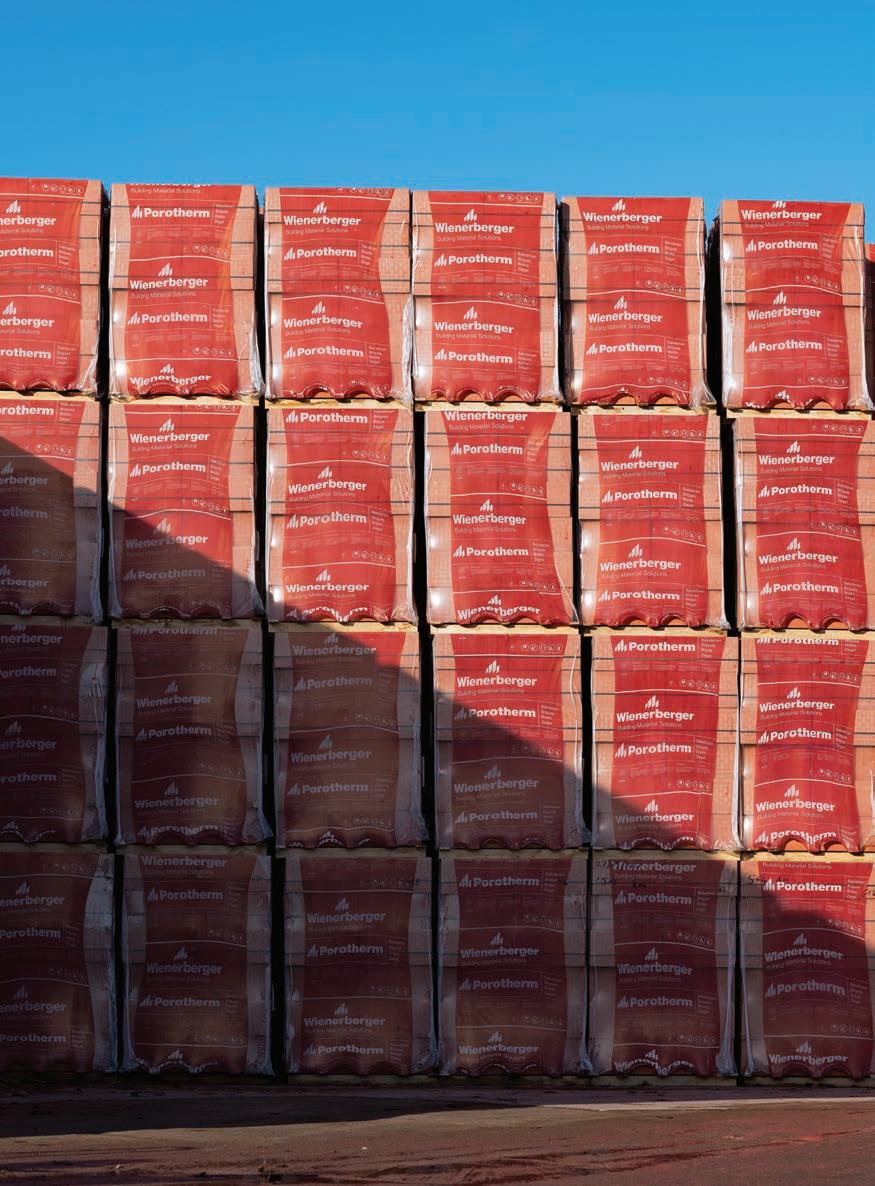
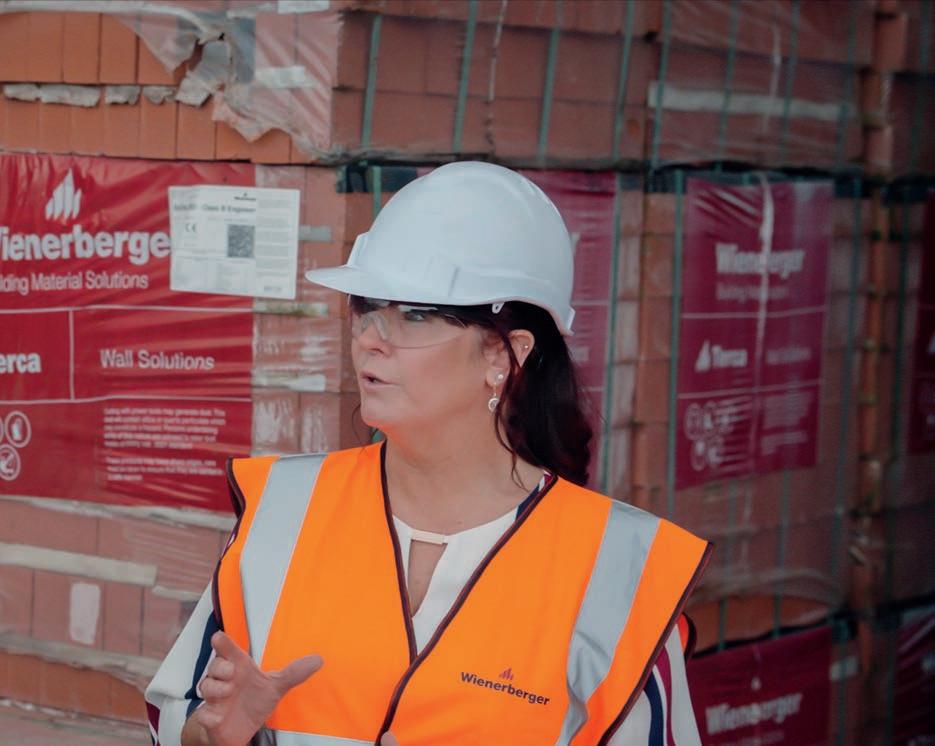
Through regular communication, expert technical support and high-quality materials, we can build a lasting relationship. By working in partnership, we’ll ensure you have the perfect range for our evolving eco-conscious market.

Together we are
To
find out more scan here:
BIGGER PERFORMANCE. BETTER FOR BUSINESS.
No wonder so many business-minded installers are switching to Geberit Mapress. Quick and easy to install, with no hot works or costly one-hour cooling down period, our advanced pipe fitting solutions offer leak-free, hassle-free performance and unrivalled support. By anyone’s standards, that’s what you call a result. geberit.co.uk

GEBERIT MAPRESS























 Caroline Gumble CIOB
Caroline Gumble CIOB


 Steve Frizell
Steve Frizell





























































 Jessica Stanway JMW Solicitors
Jessica Stanway JMW Solicitors




































